
The Change Stories is a cross-border collaboration project co-created by Maze Vietnam from Vietnam and The Optimist Citizen from India. We cover multi-media stories of the world’s top social innovators in ChangemakerXchange summit with an ultimate mission of inspiring people from across the world to become changemakers, together creating positive changes and making the world a better place.
Contents [hide]
What is The Change Stories?
The Change Stories is a cross-border collaboration project co-created by Maze Vietnam from Vietnam and The Optimist Citizen from India. We cover multi-media stories of the world’s top social innovators in ChangemakerXchange summit with an ultimate mission of inspiring people from across the world to become changemakers, together creating positive changes and making the world a better place.
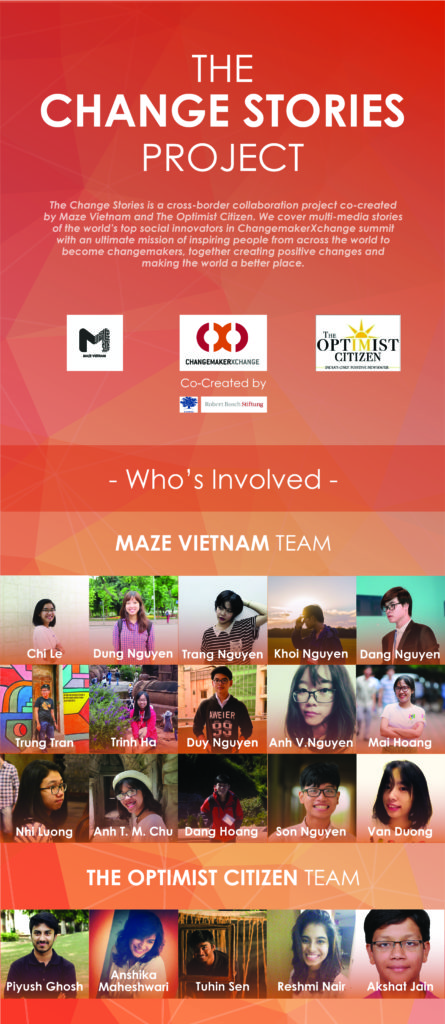
How does The Change Stories work?
How was The Change Stories born?
“We almost finished all. The collaboration project.
Please let me take a moment to breathe! We felt like we almost died. We were all in ‘Fast and Furious’ mode. Good thing. We’re still alive. We’re just still cool all in all.
Four months ago, our project – Maze Vietnam was in Top 20 social ventures in Singapore ChangemakerXchange Summit co-created by Ashoka & Bosch Robert Stiftung. The summit gathered all founders and co-founders and it was a great opportunity for me to learn and to grow. There I met Piyush Ghosh, the founder of India’s only positive Newspaper – The Optimist Citizen, and we had a lot of overlap in terms of project ideas. We finally came up with a collaboration project named The Change Stories, developing multi-media stories of top social innovators in this network, aiming to inspire the world.
Piyush and I had an initial thought of collecting the stories by selecting highlight profiles out of hundreds within Ashoka network and launching skype sessions. However, in the nick of time, when we knew there would be an upcoming summit gathering the most recent changemakers, we eventually decided to send a proposal and head off right there, for real-life conversations, real-time interviews and all. My team – Maze Vietnam and I were supposed to develop articles, photos, infographics, videos and all these cool things up there.
For the community. For the world. We serve the community.
Before the arrival date, Piyush and I split all summit attendees into 2 groups each. So my team took charge of 10. You may think I had proper interview sessions but no, the reverse was true. All phases of the summit were tightly scheduled and a single proper interview session could hardly be looped in, let alone over 20. So I interviewed them, living in all the conversations for stories whenever and wherever I could: In the morning bus ride off the teeter-tottering motion, in the late afternoon with all howls from the wind for a beach walk, in lunch and dinner with all the noise around, in the canopy just a few meters away from all the neighborhood’s DJs music tracks rocking the space, well, anytime, anywhere. There was nothing called note-taking part in these informal interviews. I just had my phone full of battery in my pocket all the time, always in ready mode to switch the voice recorder on. Collected all their words in mind through the recorder. Fortunately, I successfully approached every single person and finally had conversations with them. It’s just funny that whenever I saw Piyush, our “hello” was removed by a common question: “How many people have you interviewed?” as we both knew we didn’t really have time to do it. All-interviews-are-just-snap-and-quick-but-fun. On the 4th day – just one day before the departure date, he told me “I got 3”. I smiled “3 Indians, right?”. He laughed and nodded. He had the stories of these 3 before he came there. It still might count, of course!
I arrived home and sent out all the documents to my awesome team, leading them to develop multi-media stories. We spent all the nights long listening to all the recordings, outlining and developing their stories, editing and retouching all shoots of videos and photos, and much more beyond that. We were always in speedy mode and tried all our best to work efficiently.
There have been some pretty hilarious and tough situations in the last 2 weeks and we would walk you through by now.
Although all the raw recordings were not of good quality, some photos were not of high resolution, and more stuff un-okay, we still handled all pretty well with our brainpower. We strived for excellence, flawlessness and ‘fast and furious’ drive!
This cross-border collaboration project is challenging but fun. I’d like to take a moment to thank all the great people – all Ashokars, RBSers, CXCers, Maze Vietnam-ers, and TOCers who make this happen. All productions from Maze Vietnam Team were already submitted and hopefully will go viral in the very near future! Then all the feedback and recommendations are always appreciated! We are always up to learn!” – Chi Le, Sept 26, 2017
How did we develop the stories?
“The collaboration project has finally come to an end. And I can say that I am definitely not going to miss those “darkest days”. I remember staying up until more than 3 am to submit the post before the deadline. Not to mention, because the audios are totally in bad quality, so it was like a “mission impossible” to us trying to listen to what the participants were saying about and transcribed them out. And there goes a bunch of documents, project websites, and data that we had to analyze to get the clearest view of the characters we were writing about.
At first, I just signed up for one post, but then after I finished mine, I had to turn out to help Trung, my other teammate to finish his because he had been assigned for two posts. I still remember that night, he texted me at about 1 am and said: “I give up.” “Oh, poor my little guy,” I thought. So I finally came to help him finish his post but believe me, when I opened up the audio of the post, I had to turn it off after the first ten seconds. Extremely poor quality because of the background noise I must say. Because it was not recorded in the studio but by the SEASIDE so yeah, you can imagine how it felt. Oh, such a pain! Not at all romantic! But the pain didn’t end there. After writing, there goes the editing! Editing to infinity and beyond! But in exchange, it was a great experience when I can learn about great people who are making big changes in the world by taking small steps. And for a writer like me, and my other teammates in the team, besides making readers understand clearly what they are reading, we also try to bring up the message that the character in the post wants to convey. And above all, every single word must be in full honesty. So yeah, I can write more but since it’s quite long already, so maybe next time!” – Trang Nguyen, Sept 27, 2017
“Yes, the collaboration project has come to an end and I must admit I’ve already missed those white nights. Having said that, at first when being informed about the project, I was really worried as I’d never written a story before, much less a biography of someone whose organization’s influence is so significant and reaches a variety of demographics in a country.
As soon as I knew that my assignment was to write about the success story of Kelly Ann Zainal, an energetic Singaporean girl and how she came up with the ingenious idea of establishing Human Library Singapore, my confidence gradually returned in little strips, building up in layers. Much to my surprise, there is also a Human Library organization in Vietnam which I had a chance to personally participate in one of its reading sessions. From my own experience, this is such a meaningful project for prejudiced and discriminated people to sincerely share their deepest emotions and for readers to explore and move beyond stereotypes. And now given the opportunity to promote it, I couldn’t be more honored.
Guess I was luckier than my teammates as the interview seemed to have taken place in a good place with the very limitation of background noise, so the recording was easy to hear and transcribe. Through it, I was able to comprehend Kelly’s life stories and her journey to Human Library Singapore. Though the recording itself was really informative, I wanted to understand more about the project and its popularity in Singapore so I delved into all the articles and data that Chi gave me as references and other information via the project’s website and Facebook page. That took me 1 sleepless nights and 2 more nights for the complete writing. Tired but worth it!
Needless to say, being a part of this project is definitely an invaluable experience for me!” – Trinh Ha, Sept 29, 2017
“I must admit, my thoughts are better transcribed when talking about someone else, but here are a few of my musings on writing about Redza and Gwen. I came in, a bit confused, on whether or not I could truly captivate their stories. (I’m still unsure of whether I did or not, really, but I tried my best anyway.) Along the way, through my short journey, I became inspired. I learned about community, about the sense of discovery, the sense of innovation, and so much more. I was given a glimpse into the lives of two humans – two very extraordinary ones, indeed – and told to do something with it. I can only hope that whoever manages to read my articles come out as educated and inspired as I was writing them.
To Gwen (whose pauses are a healthy irritation during my transcribing sessions) and Redza (whose accent, combined with an audio recording that’s more wind than voice, made for an extremely interesting hearing, to say the least), you two have been some of the most interesting people I’ve written about. It was a pleasure learning about and writing about you guys, and I wish you the best in your future endeavors.
Who knows? Maybe I’ll be a guest at a future Tribeless dinner!”- Trung Tran, Sept 30, 2017
“You know the moment you tell yourself you’ll rest your eyes for just 10 minutes but it does not last just 10 minutes. It lasts longer. It always lasts longer. Much longer. I have a fair share of those incidents myself, the latest being Saturday, September 17.
It was 10 pm, exactly 12 hours before my deadline, and I still had 1000 more words to write. My eyelids, however, had a different plan for me as they kept shutting down, begging for a tiny little break. Little did I know, that break dragged on to the next day. Normally, I would have slept till noon but that day, some higher force, probably my guilt (but I prefer to think it is my sense of responsibility), pulled me away from the ever-alluring sleep at 4 in the morning. First
thing I did was fix up an authentic Vietnamese iced coffee, as authentic as a Nestle instant coffee may get. To my credits, I opened my laptop and got right to work.
I wrote about Ken, the founder of (these)abilities which is a social startup that invents products and organizes events towards an inclusive community for people with disabilities. I was so inspired listening to Ken talk about his company that I wanted the readers to feel the same electricity running through their veins. I wanted my piece of writing to be able to reflect the massive passion that drives the organization, so I was beside my thesaurus throughout, making sure that every single word carried a certain weight.
To sum up my hours of writing, it was a pattern: Listen to the recording. Take notes. Research. Coffee. Write. More research. More coffee. Rewrite. Write. Rewrite. Rewrite. And more rewrite. I knew rewriting was crucial and intense, but my god was it grueling. Every sentence needed to tuck in nicely with each other. The amount of information had to be sufficient but never excessive. Everything was pushing me to the edge of insanity, but at least the final product is not half bad. I was proud, very much so. It was the first time I had spent no fewer than 7 hours straight working on a project. It was strenuous and nerve-wracking, but it was worth it. You know in movies there are scenes where voluminous writers or computer geniuses sitting by their computer, typing vigorously in a corner of their room blanketed by complete darkness and silence; the only source of light comes from their screen, sound from their keyboard. Well, that Friday, I was one of them. Sorta.” – Nhi Luong, Sept 29, 2017
“A new member joining Maze Vietnam for a week and then Chi asked me whether I wanted to take part in the project The Change Stories or not, but I hesitated. I didn’t have enough confidence in my writing skill since this was the first time I’ve done something like this and I did not want to let anyone down. However, thinking again, with such a precious opportunity like this, why not?
Maybe I’m luckier than other team members as I was given a story of a Vietnamese student- Trinh Nguy. She was about my age and what she has achieved with her successful project “Moving to raise”. Additionally, different from others who have to approach inspiring stories through audio records, I received a brief summary of the interview and had the chance to talk to her directly, through online platforms. She was such a friendly, warm-hearted girl with lots of energy. Through Trinh’s story, I comprehended better about a grievous issue in Vietnam, which is human trafficking and the stories behind it. Albeit her busy schedule, she always tried to answer all my questions as soon as she could. Moreover, not only stopping at simple “question and answer” type of interview, she also gave me much valuable advice as well as corrected inaccurate parts in my article so that it would be better.
Nevertheless, it was not easy at all to finish the writing about “Moving to raise” when I have never dug deep into human trafficking issue. Thus, how could I find the inspiration to express authentically all the beautiful meanings that M2R possesses while I knew nearly nothing except for its definition? The best way to truly understand the problem is to observe it. Therefore, I went on Youtube to search for videos about human trafficking and what I found in those clips terrified me. Never have I thought that a person would have to suffer through those pains and loss. That severe damage they have been through attaches deeply to their soul, and it forms their characteristics- shy, ashamed and scared of talking to strangers. Therefore, after watching those videos, suddenly I wanted to write. Everyone needs to know about this, no one should be indifferent to this problem. If everyone is aware of human trafficking’s horrendous consequences and more projects as “Moving to raise” is implemented, will it still exist and develops more and more complicatedly as now?
It took me nearly a whole week to finish this task, which was longer than my normal time for writing travel articles. But above all, maybe this is the one that I probably satisfied most because I’ve put all my heart and soul in it. Finally, I just wanna say “Thank you” to Maze Vietnam and all other organizations for bringing me such an amazing opportunity to meet an extremely cool person, apprehend her story and contribute to something big.” – Anh T. M. Chu, Sept 26, 2017
“I am Son from Maze Vietnam and it’s my honor to share this story about how I actually felt when editing the videos.
I first knew about Changemakerxchange about 1 month ago and since then I’ve always been curious about the purpose of the summit. What do changemakers actually do and what impacts they have on the humankind? Hmmm, they must be really professional and definitely unfamiliar to me.
And not for long that became a misconception. Recently I edited a video on the topic: ”What makes you become a Change Maker?”, starring the participants. At first, I was really worried that the video must be as formal as possible for the ideas to spread even further. But then I received the raw videos from Chi and I was like “Wow, this is not formal at all.” There was always laughter in the background and an idea popped into my head: ”How about editing this in a hilarious way?” Then I automatically searched on Youtube with keywords: “troll background music” and just went with the flow. I laughed a lot when editing as the participants were so funny and friendly. It’s so relieving when Chi actually compliments on my product and the participants say they love it! ” – Son Nguyen, Sept 24, 2017
What did we contribute to The Change Stories?
Our products for The Change Stories have been bringing significant impacts on thousands of people across the world. We strongly believe in the potentials of the collaboration project which will definitely deliver an ultimate mission of inspiring people from across the world to become changemakers, together creating positive changes and making the world a better place.
Ten Powerful Stories
Tribeless – Building a Fire for Community
The story was originally posted on:
http://changemakerxchange.com/gwen-yi-tribeless/
Story written by Trung Tran – Photos shared by Gwen Yi Wong
Wong Gwen Yi – or Gwen – is no stranger to connecting people: She has been in charge of marketing TEDxKL, the biggest TEDx conference in Southeast Asia, and building Kuala Lumpur’s tech startup ecosystem with Startup Weekend and Tech in Asia, amongst other projects. She is also no stranger to the hardships of taking the road less traveled, having dropped out of college not once, but twice. The perfect combination for a project like Tribeless.
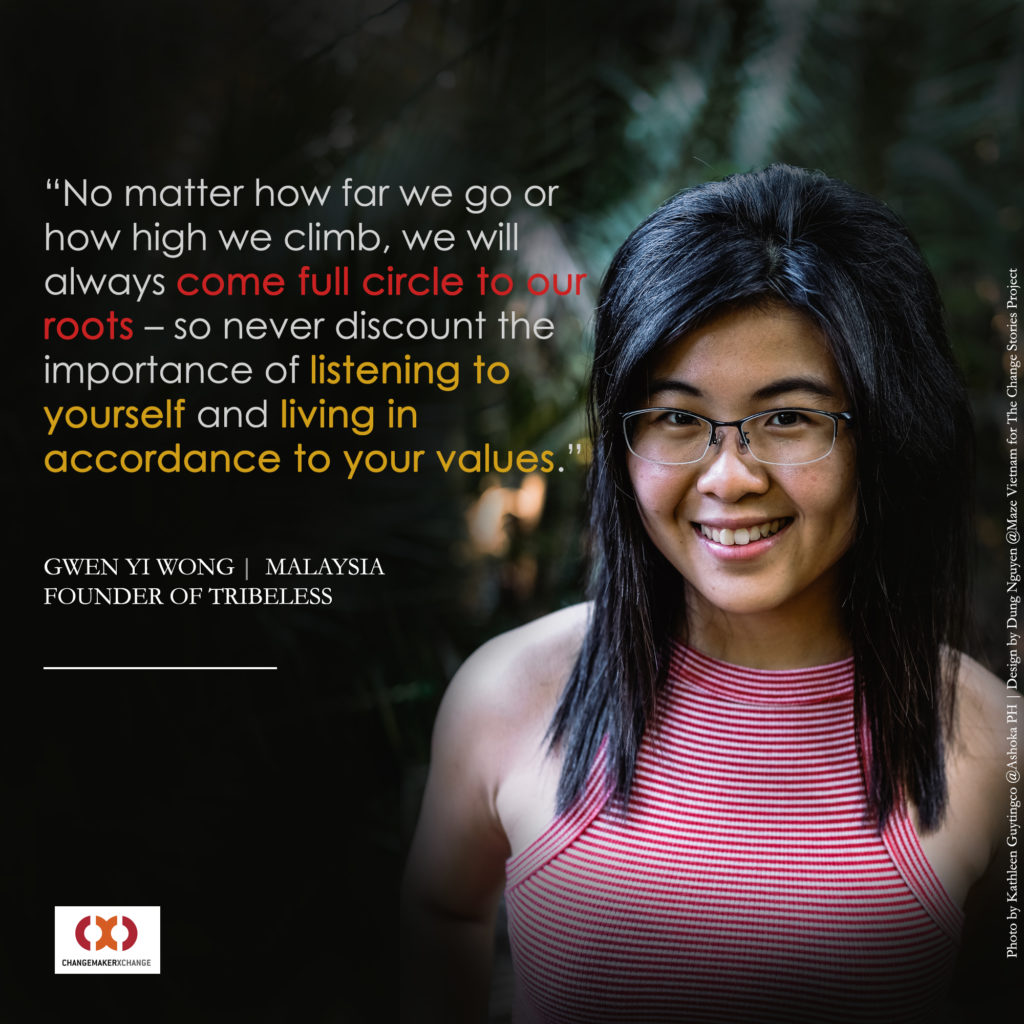
So what exactly is Tribeless?
Imagine this: gathering 10 strangers for dinner, inviting them to share their deepest secrets and inner turmoils, and listening to their stories of love, fear, and ambition. Sounds like something straight out of a novel, right? Yet, over 20 dinners have been hosted in Kuala Lumpur and Singapore; with plans to host in Melbourne and Seoul, among other cities. It is a refreshing reminder of the sense of community and camaraderie that is missing in today’s society.
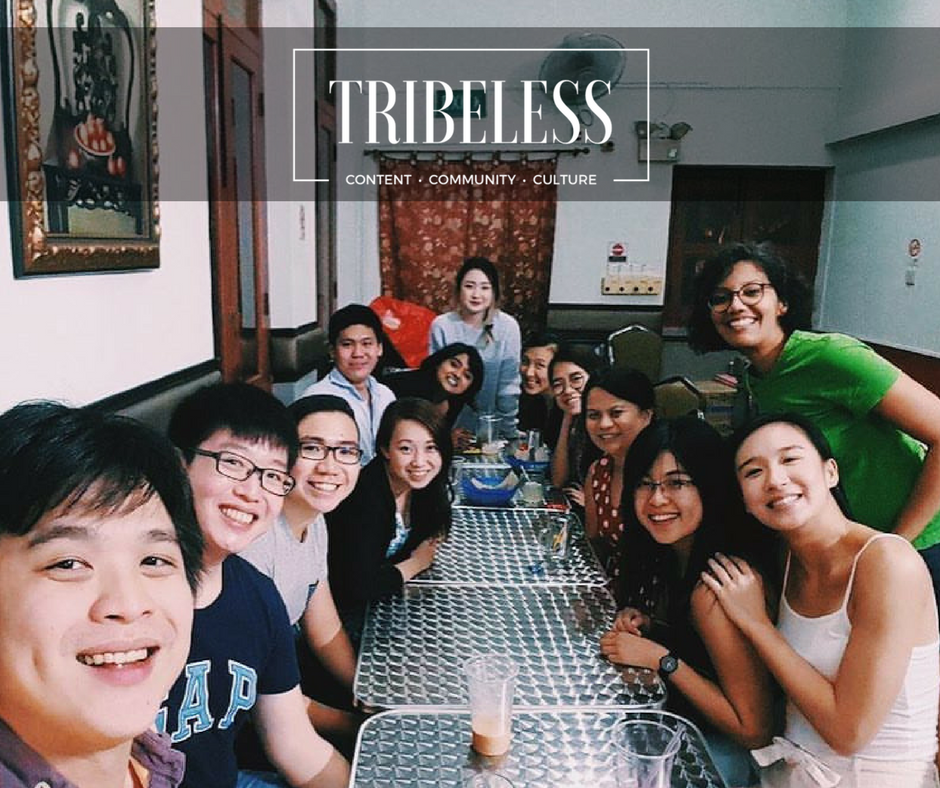
Communication. Empathy. Curiosity. Vulnerability.
In this tumultuous world, we feel lacking in these attributes at times. Think about it: When was the last time you had a heartfelt, face-to-face conversation with another person? When was the last time you truly felt shaken by someone else’s plight? When was the last time you felt the aching childlike desire to deeply know another? It is perhaps ironic that in this seemingly “connected” world, we are more disconnected than we have ever been. Overly tense professional lives, a focus on the virtual world, and a general sense of stagnation in life have led to a lack of communication and empathy between human beings. This sense of isolation, coupled with a neglect of our general well-being, has led to a rise of mental health problems such as stress and depression in the recent years, and the trend is only going up.
We are burnt out, washed up, and worn down – for good reason.
We, humans, are a communal species. We need conversations; we need empathy; we need communication. But where would we find these things? Where could such a platform exist, somewhere where we could empathize with each other, somewhere where we could have heart-to-heart conversations, somewhere we can be ourselves, away from life’s expectations? That is where Tribeless comes in.
So how did it come to be?
For Gwen, it is a reflection of her life’s journey.
“I always have had an interest in social impact. All the way back in high school, I was a complete overachiever. I was volunteering at all these conferences, doing all this volunteer work. So when I went to college, I felt very alone because I realized that nobody else was interested in the same things. So I started organizing small group discussions where we would talk about things that mattered to us. At that time, I was interested in philosophy, so we were discussing topics like, ‘What is the meaning of life?’. It was interesting because you had jocks, cheerleaders, nerds, all these stereotypes coming together to have these deep discussions. They completely broke their stereotypes. That gave me a lot of joy,” she said. “Around the same time, I fell in-love with tech entrepreneurship. At that time in Malaysia, where I’m from, it was an up-and-coming thing. So I transferred my overachiever-ness into that. So I went all out: I learned how to code and build products. I was obsessed with Silicon Valley, Mark Zuckerberg, that kind of stuff. The pinnacle of my story was when I had the opportunity to move to San Francisco. It’s the dream of everyone who’s into tech to go there. And I thought, ‘I’ll be really happy here.’ Turns out I wasn’t. I developed depression. I developed social anxiety. I felt like I didn’t know who I was anymore.”
“Ultimately, I realized how important relationships were, how important social support was. So I came home to Malaysia. I didn’t have anyone to talk to. I was spending my Friday nights alone. Eventually, I told myself: Something has to change. I need to step out of my own bubble. I need to start reaching out to people. I can’t go on like this.”
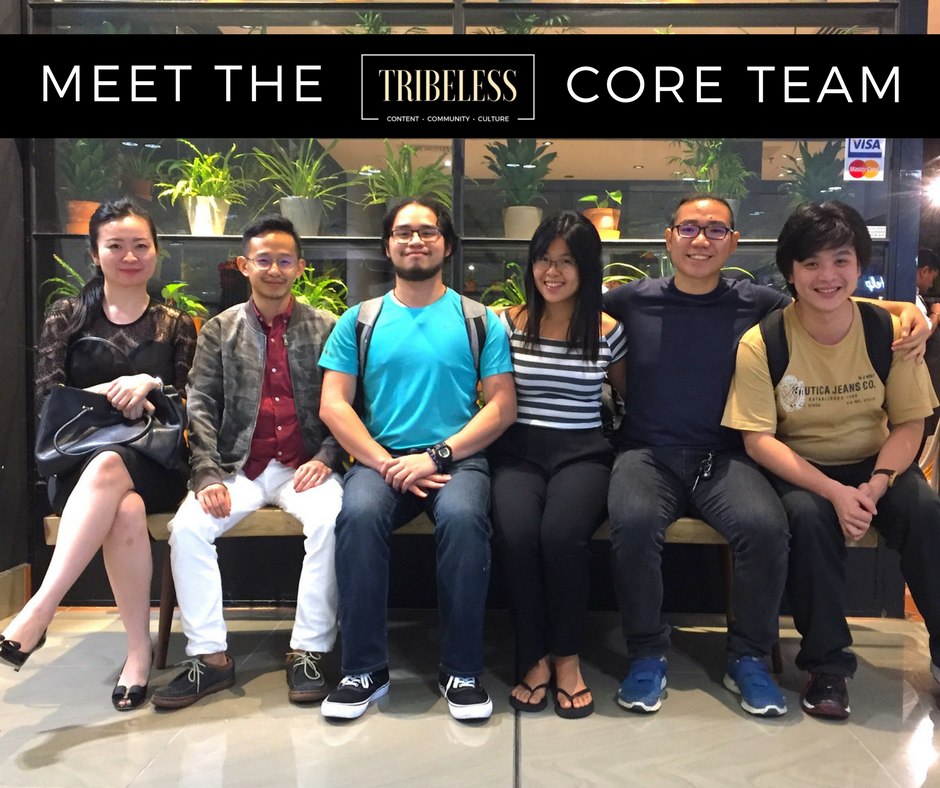
And thus, Tribeless was born.
“So I started organizing these dinners called Tribeless Dinners, in which I would gather – again, similar to what I did in college – groups of people to just come and talk. And the reason they would come is not for a theme like, you know, Republicans versus Democrats or anything. They would come simply because they resonated with the values of openness, of empathy, of understanding other people, and also understanding themselves. The discussions would always be very deep and authentic. People would sometimes reveal things that they wouldn’t even share with their friends or family. Personally, I learned how to be vulnerable. I learned to stop prioritizing my career and my achievements and to start building relationships instead. Now, I feel like I have come full circle from that time in college when I was trying to be someone I wasn’t.”
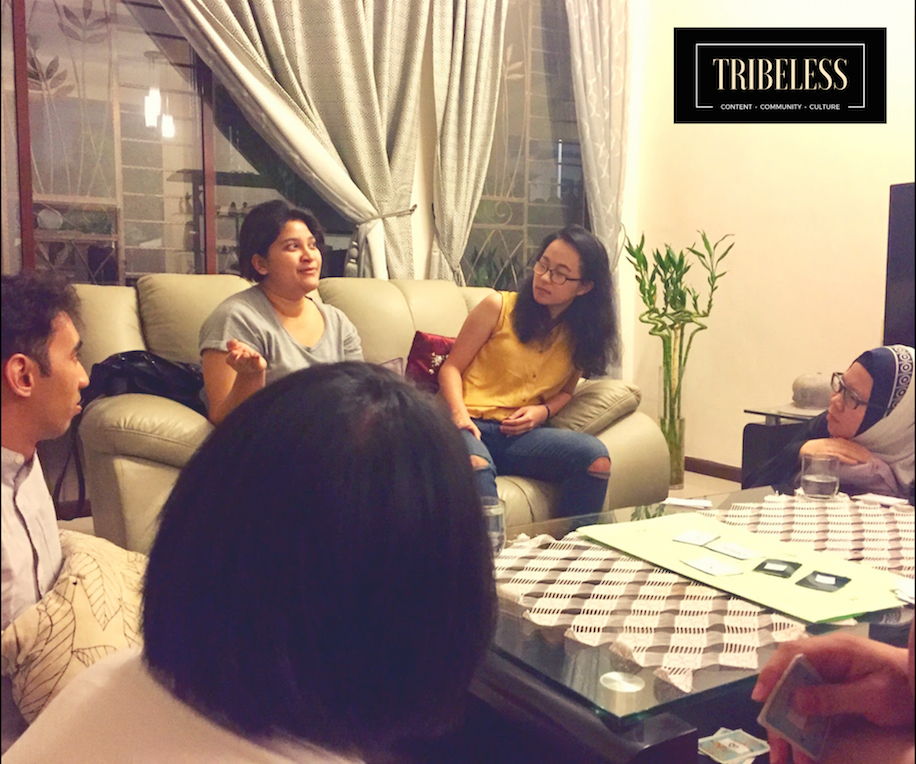
The more dinners Gwen held, the better she realized she was not alone in her plight. Many others were struggling with personal issues and lacked a safe space to explore, grow and connect.
“As I was going through depression and anxiety, I realized that I wasn’t the only one. How many of you have been in a situation where you and your friends are sitting around a table, and all of you are just playing with your phones?” she asked, “How many of you have a personal story that you want to tell people in your life, but you just never had the chance to because they are not accepting? Or even worse, they aren’t giving you a voice? They tell you: ‘No, shut up, just get over it.’ That’s what people told me about my depression.”
“There’s this thing called emotional loneliness, which is different from social loneliness. I had both. I didn’t have friends, and I also didn’t have people to talk to about my emotional problems. Emotional loneliness can happen even when you have a huge friend group and several people you hang out with every day. It’s still something that you can suffer from.”
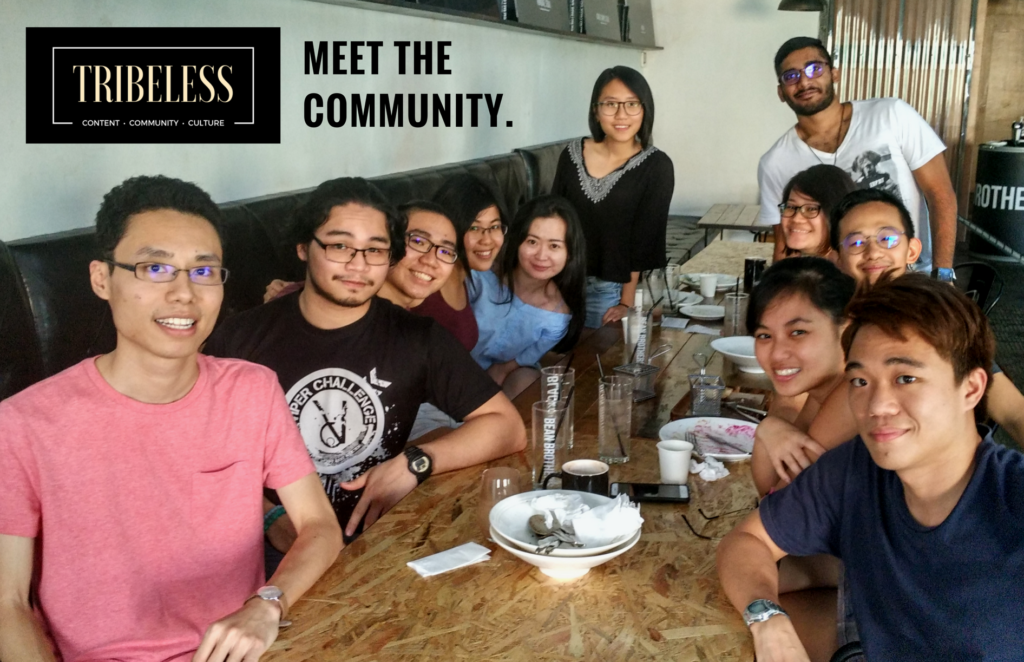
Gwen sees Tribeless as an ignition, a spark to begin lighting the fire that is human connection. The project’s success is, according to her, a result of rigorous planning, and a sense of openness and vulnerability from the participants. “How do you build relationships in your life so that you can actually support and trust each other? Paulo Coelho, the author, said: ‘If you want to change the world, you have to go back to a time where warriors would gather around the fire and tell stories.’ I believe we are all warriors. We have gone through so much. We fight our own battles. And the way we can change our world and change other people’s worlds is when we share our stories and own those stories. So, instead of an actual fire, I gather people around dinner, and people will come and talk, and it’s facilitated, so that it’s not like anyone who doesn’t actually care could come in. That’s how we build our community.”
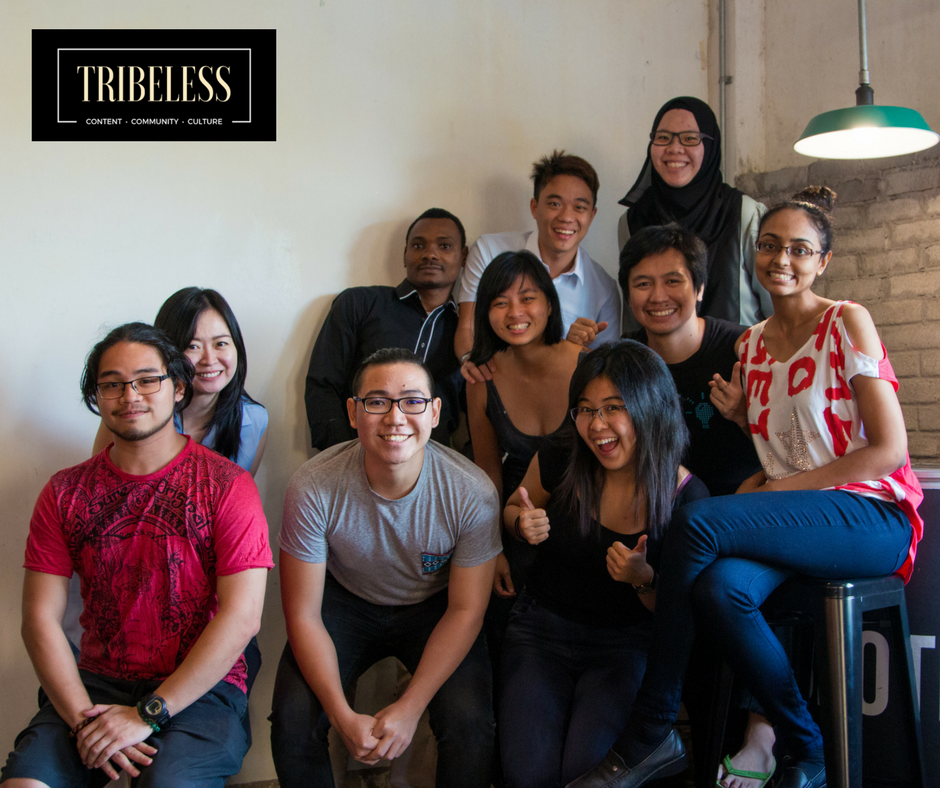
Gwen believes that the Tribeless experience can be replicated anywhere, not just over dinner. “After hosting about 20 dinners across Malaysia and Singapore, we realized we had it down to a science. We were able to create a safe space for everyone to open up and share, no matter how diverse the group was. So, we decided to take the mechanisms of the dinner and turn it into a game. We’re prototyping it; at the moment, it’s called ‘Tribeless In A Box’. Our ultimate goal is that you can take this game, and you can play it with anyone in your life, and just like that, you can get to know them so much better. You can build stronger relationships with them, which will eventually lead to stronger communities as well.”
Gwen believes she has developed personally along with the growth of Tribeless. “This has been a crazy journey for me. Because Tribeless is so personal, I have had to learn and change a lot about myself in order to grow the business, which is quite different compared to other kinds of business. Say for tech startups, you’d need more users, more revenue, or whatever. But it’s not like that for Tribeless. I feel like the more I grow as a person, the more the company grows as well.”
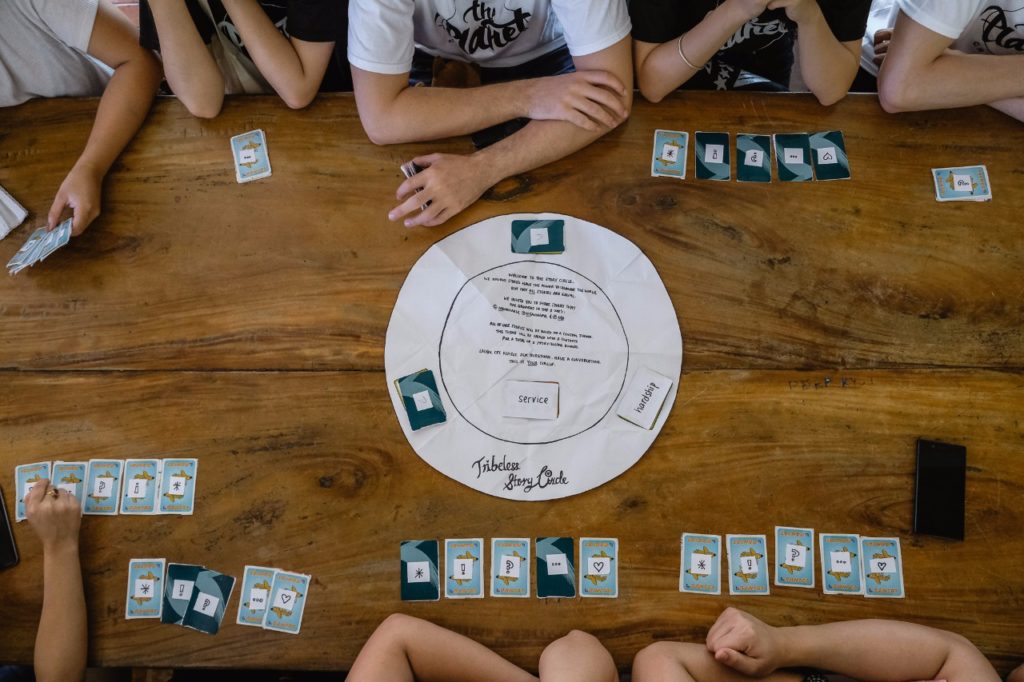
Gwen is a curious subject, one must admit. When I started writing this piece, I did not expect to come out this inspired. She is a story of her own – a story of a young Asian entrepreneur, a story of a young person coming to terms with their personal demons, a story of a pioneer in the community, and so much more.
Gwen’s personal website proudly displays the tagline #30Mby30 – she wants to positively impact 30 million lives by the time she is 30. After having a small talk with her, my team and I did learn a lot of new things and slow down our pace of own life to reflect ourselves from her story. And I do hope that you – the reader – will come out with this feeling as motivated as I did. Who knows? Maybe you will help her reach that goal sooner rather than later.
Let’s talk about it: Sexuality
The story was originally posted on:
http://changemakerxchange.com/samuel-galler-sticky-rice-love/
Story written by Chi Le – Photos via Sticky Rice Love Facebook Page
Recent advancements in technology and communications have pulled the East and the West closer than ever before. However, when it comes to sex, the social gap between Asians and Westerners has not really narrowed.
Relationships and sex may cross one’s mind at one time or another, and Westerners may be more likely to engage in open conversation on these topics. Yet, in Asia, talking about sex is often considered a taboo. Discussion about “the birds and the bees” are often passed over in Asia, and some children have no idea how they came to be on earth. For younger generations, whether in class or at home, Asian students often feel uncomfortable bringing up these “naughty” topics, not to mention related issues such as sexual health. Instead, most are self-taught, hearing and learning everything about sex through the only available means: movies and the Internet; it is not surprising that many find the subject of sex embarrassing and may never feel comfortable asking how to do “it” safely. Since a proper sex education is rarely implemented in Asian school curriculums, young people often have limited access to studying sexual health comprehensively. Consequently, they are at higher risk of suffering from unplanned pregnancies, sexually transmitted diseases (STDs), and other serious repercussions.
Young Asians are in desperate need of spaces that encourage the ethos of “Let’s talk about sex”. In order to address this issue, particularly in Hong Kong, Samuel Galler, and his co-founder, Julia Sun, came up with Sticky Rice Love (糖不甩), a friendly platform designed to improve physical, mental, and emotional dimensions of sexual health, sexuality, and relationship education for young people in Asia.
Having a strong passion for language, culture, and social science in China, Sam successfully graduated with a joint BA and MA from Harvard in East Asian Studies and a minor in Global Health & Health Policy. He is now a Ph.D. student majoring in International Development at Oxford University, which involved extensive fieldwork in China to study different Chinese HIV/AIDS organizations. While doing this research, he went to Hong Kong to do a related project on HIV rapid testing provision. He interviewed a lot of key stakeholders involved in HIV prevention to understand how their local knowledge influenced their perspective on HIV.
Through his research, he found that in Hong Kong, a lack of sex education was a major barrier to people taking advantage of available resources such as free HIV testing and counseling. In addition, he spoke with a number of experts on science education and education policy in Hong Kong universities and secondary schools. From these conversations, he discovered that there were many obstacles to delivering sexual health education officially within high school and middle school settings. Biology teachers were often uncomfortable talking about sexual health issues and were not trained to discuss these topics sensitively and effectively. The government requirements for sexual health were only recommendations, and as a result, most teachers tended to spend little time covering this information, since it was not a required part of the curriculum. Many parents may think that not teaching children about sex means they will not have sex and nothing will happen. However, in reality, not teaching children about sex means they are more likely to have unsafe sex or make poorly informed decisions.
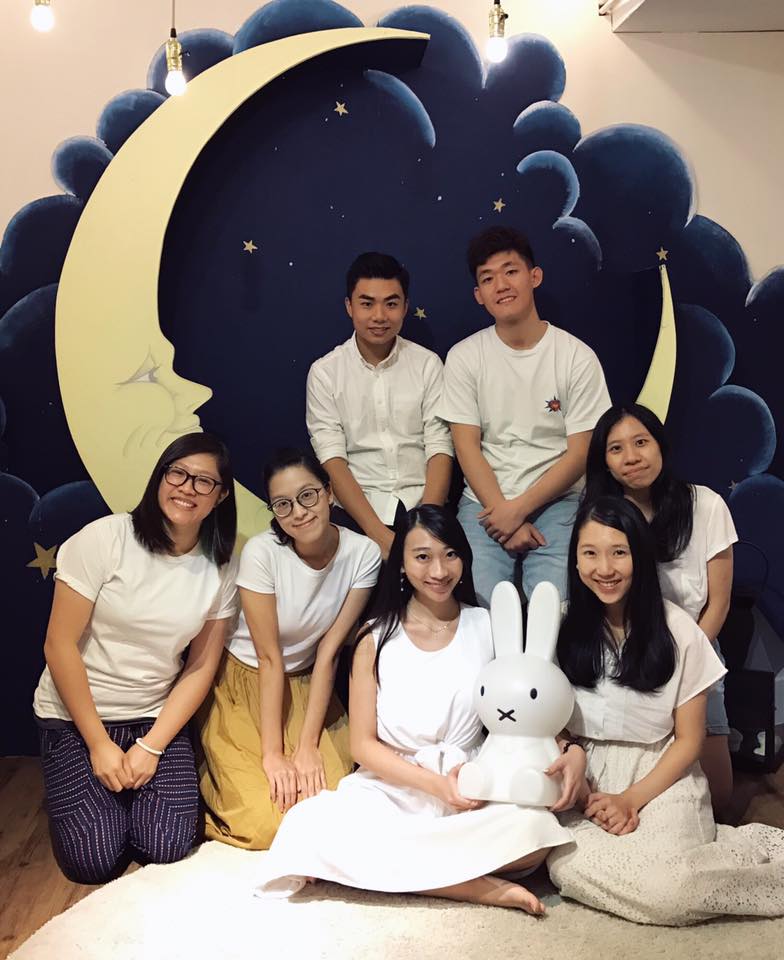
Sam met a number of people in Hong Kong who were interested in his project and decided to build an organization that can address this issue. Through a social enterprise co-working space called The Good Lab, which encouraged entrepreneurs to meet, work and collaborate through different meetups and networking events, he met Julia, who was already conducting her own sexual health education project as well. They had a lot of overlap in terms of project ideas, so they soon figured out how they could work together. Thus, in late December 2013, Sticky Rice Love (糖不甩) was born.
Sticky Rice Love (糖不甩) concentrates on sexual health education for young people in Hong Kong with the model based on the idea that they can crowdsource different ideas from young people to improve sexual education. This organization’s name refers to a Chinese sweet dumplings dessert, 糖不甩, and it suggests that talking about sex can be fun and should be as common as talking about food or dessert. Sticky Rice Love is known to be an open and healthy platform, letting people feel free to talk about sex in a non-judgmental and safe atmosphere. Its main aim is to enhance young people in Hong Kong’s sexual health knowledge covering relationships, puberty, contraception, sexual diversity, decision-making, communication, etc.
Sam and Julia were able to build the team and brought it to Make a Difference, an annual conference in Hong Kong for social projects, enterprises and charity work for young people. They received a lot of feedback on what they were doing and eventually settled on a number of different features that they wanted to build into their organization and website. Their website,stickyricelove.com, launched before Sam left Hong Kong. Sam and Julia worked on basic branding and held a small focus group with representatives from 7 out of the 8 main Universities in Hong Kong. The group provided feedback that would be used to improve and guide their project. Since then, they have moved in a number of different directions and maintained good relationships with a lot of organizations that they had already made contact with very early on. They received initial funding from the Magdalen College Trust and the UnLtd Foundation HK and gained access to professionals for consulting, training, and linking to other key stakeholders. After Sam left Hong Kong, he served as a mentor and assisted in fundraising, while the other co-founder and director of the organization, Julia, managed all of the organisation’s operations including marketing, recruitment, training, and strategic planning. In the first six months, they had a rough start and nearly gave up several times, but they ultimately persevered, growing and training more than 40 volunteers. These volunteers are regularly involved in different activities such as school workshops, public events, where people can talk and share their experiences, film collaborations with sexual health relevant films or sexuality, and open events for discussing important topics related to sexual health. They also have developed partnerships with other local businesses and charities that have generously supported their work.
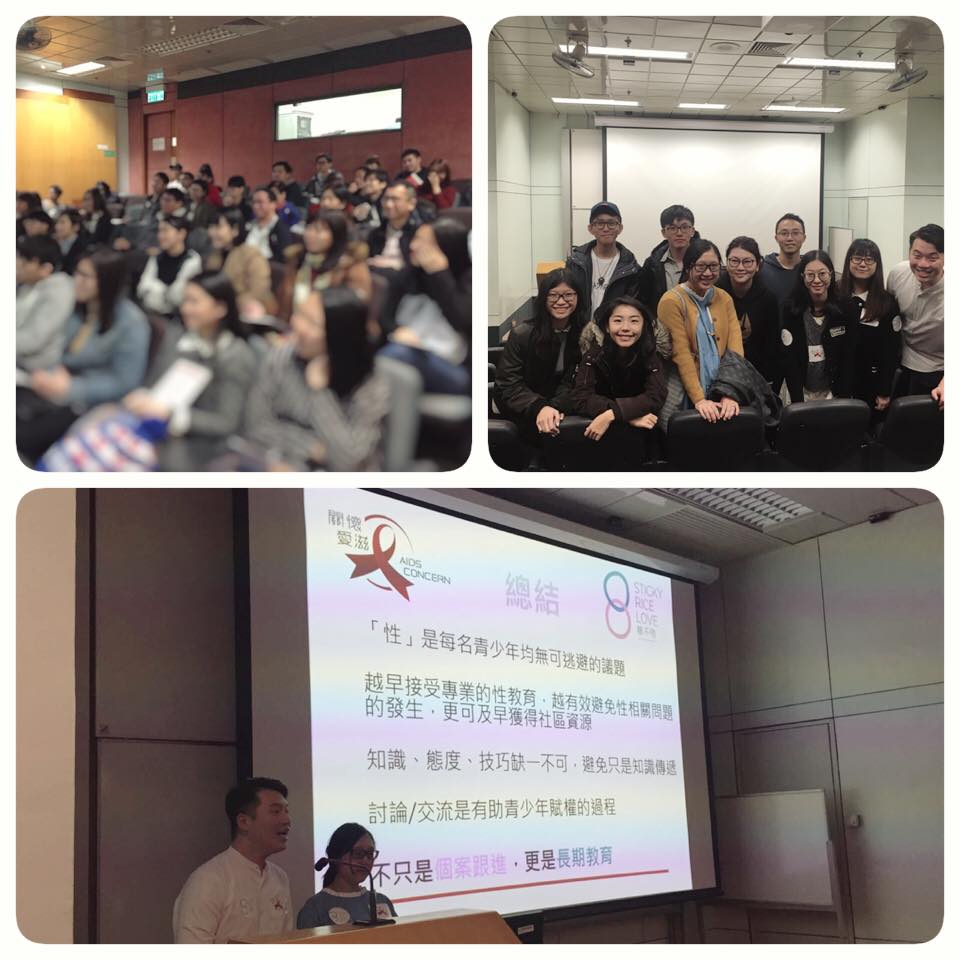
Sticky Rice Love has many online platforms that emphasise youth empowerment in topics related to sexual health, sexuality, and relationships. Their services include active Facebook and Instagram pages, as well as a forum and an anonymous question box service. These allow individuals to ask questions anonymously, and their organisation helps to provide support and link individuals to relevant professional services. Sam said, “There are many questions that we cannot answer. But we try to give people as much information as we can. We try to give them a decision-making framework so that they can make their own decisions. Some situations are really hard. We try to provide key skills and information that can support people to make positive decisions about what they are doing that will support their health while making them feel confident and good about what they are doing. We recognise that real-life situations can be very complicated.” Many questions they receive are just not ‘Googleable’ and have to be resolved through extensive two-way conversations. Hence, Sticky Rice Love (糖不甩) is a very good solution to this. People feel comfortable engaging with the organisation’s social media pages, email account, and other messaging applications to talk about sex and relationship openly.
In sum, relationships, sexuality, sexual desire, and physical curiosity are all natural phenomena everyone has in their life. The premise of sex education is not just to offer lessons on safe sex practices and condom use, but also to provide an ultimate guide for students to understand themselves, gain more confidence in developing healthy lifestyles, and engage in healthy relationships with other important people in their lives.
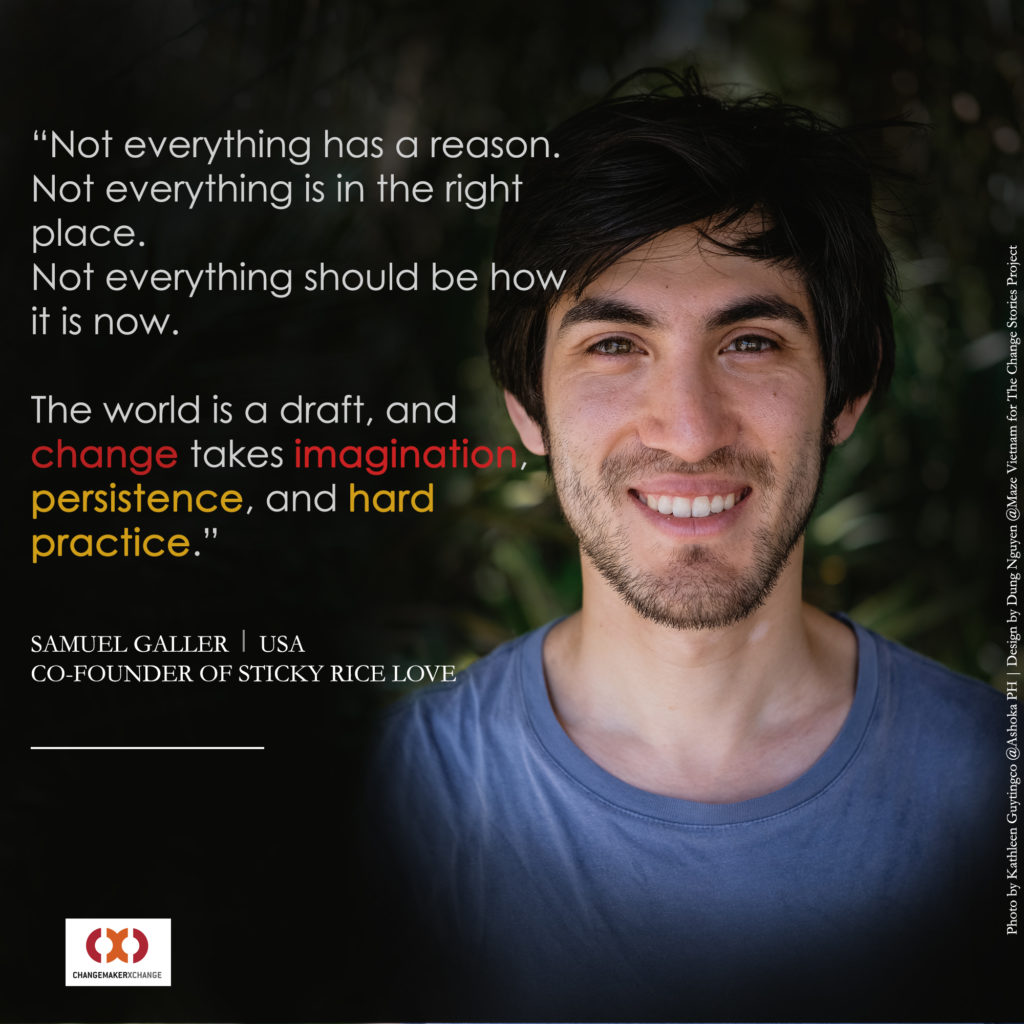
Bridging Boundaries: How To Empower Communities And Fight Food Waste, All At Once
The story was originally posted on:
http://changemakerxchange.com/redza-shahid-grub-cycle
Story written by Trung Tran & Trang Nguyen – Photos shared by Redza Shahid
Stop. Close your eyes. Think for a moment.
Think of the eggs you threw away because they were “old”. Think of the cucumbers you decided to bin because they looked odd and misshapen. Think of the bananas you did not bother touching because there was a bruise or two. Think of the slices of cake you put in the trash because no one would eat them. Think of those pots of yogurt you were going to buy at the supermarket, but you did not because they were two weeks away from the expiration date.
“But it’s just a banana!” – you say.
Multiply that one banana by a couple hundred million or so, and suddenly you get a clearer picture of how much food is wasted daily in Southeast Asia. It is estimated that a shocking 21% of food waste in the world is attributed to the region, because of wastage by supermarkets and eateries and also waste from households. And Malaysia is deemed one of the biggest culprits of this: A report by SWCorp in 2015 estimated that Malaysians wasted some 15,000 tonnes of food a day – of which 3000 are still fit for consumption. This amounts to a total of 6.6 million meals a day – quite the number when you think about it.
Apart from the obvious consequence of damaging the environment, there is a more human side to the problem: Thousands of struggling families cannot afford even the most basic of foods, and as a result, go without – while tonnes of perfectly fine food is thrown away by supermarkets, bakeries, restaurants and the like.
So where exactly will this take all of us to? And whether can an end be put to this infinite cycle of wasting? Well, when people deal with an obstacle, they struggle, fight back, and break the rules. But sometimes, they just simply give up when it comes to the “limitation” that they have invisibly created for their own selves. “Impossibility”, if it must be named. And if that “impossibility” stands for the clause of the unlikely-to-happen, then it has been proved to be untrue. For the reason, that magic has truly happened on the land of Kuala Lumpur, Malaysia, when a man, whose name is Redza Shahid, set the foundation for the one-and-only “green bridge of two boundaries” – Grub Cycle.
But what are these “green bridge” and the “two boundaries” exactly about? Basically, it is just what Grub Cycle has been doing for the whole time of its existence: reviving old or close-to-expiration date products from their “death penalty”, bringing them a new life, saving Malaysia from its own hole of wastage and bettering the life of the community. Slow and steady, one step at a time, Redza is still giving himself up to completing this bridge, making efforts in becoming a messenger, a connector of both old and new and the savior of many others. Redza sees things differently, and what he has done can be taken as “innovative” or “odd” for he did not fight back the obstacle, but turning it into a key factor in the idea of creating “new” from “old”. He wishes to do something special that could change the life of his people, the people of Malaysia.
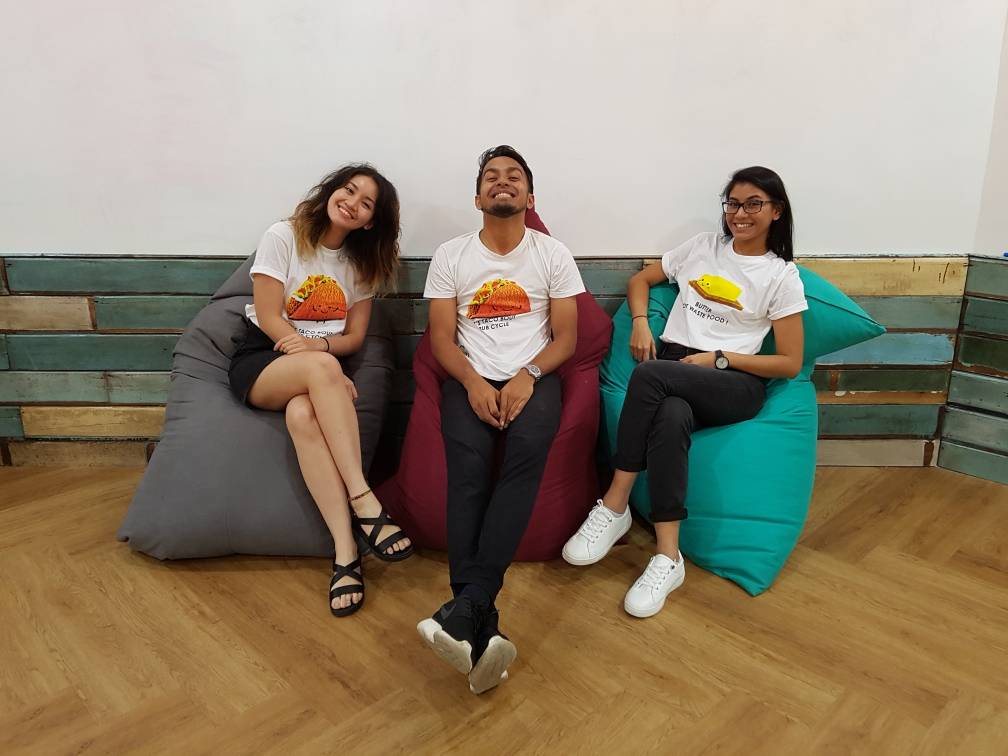
The idea of Grub Cycle – a social enterprise has already come up since March 2016, but it was not until June – with the help of the Malaysian Global Innovation and Creativity Centre (MaGIC) – that it became a reality. It is now run by 3 full-time members (including Redza) with 5 volunteers around the world such as China, France, and Africa. What Grub Cycle has been doing are purchasing unneeded (but still perfectly edible) food products – for example, items with damaged packaging or items close to their expiration dates (from 1 to 3 months) – from supermarkets, bakeries, cafes and restaurants from across Malaysia, and selling them to customers for a lowered price. Half-price KitKats, quarter-price Ferrero Rochers, and cheap extra virgin olive oil are just part of Grub Cycle’s pantry. Their other sub-ventures, Grub Homemades and Grub Bites, are interesting takes on the food reappraisal concept. Grub Homemades turns perishables such as pineapples and cabbages into kimchi, jam, pickles and the likes while Grub Bites delivers reduced-price pastries and other bites from nearby cafes and restaurants to you.

Perhaps Grub Cycle’s biggest difference in regards to other similar food redistribution projects is their community aspect. Each month, a part of their profit is dedicated to supporting low-income families with pantry products such as eggs, oils and rice. Until this moment, Grub has been helping and supporting 36 families on a monthly basis. Grub Bags, as they are called, are seen as a way to empower the families’ economy. If you need some help, simply contact Grub Cycle via email, phone or any communication platforms they have, it will always be ready to give the best it has. Grub Cycle is currently running as a social enterprise and sustaining a margin of profit from its sales, with its mission statement built on the basis of customer value and social benefit. Sharing about the side reason for Grub Cycle’s formulation, Redza once stated that the cost of living was increasing but the salary of citizens in Malaysia was still remained unchanged. Thus, this has put the food price up to 20% and posed an obstacle on lower income group for buying qualified groceries. So what Grub Cycle does to support this low-income community is using part of its own profit from sales for subsidizing the basic cost of food. Therefore, its products are always sold below the market price; for example, $12 cereal is now sold for $8. The strategy of “buy cheap, sell cheap” seems to work well for Grub Cycle. Its goal is lowering the price of products and saving money for consumers as much as possible (RM 15,520 is the exact amount of customer savings provided on Grub’s website). And with such clear mission statement, no wonder why Grub’s plans have always seemed to be one-step-ahead and surprisingly effective. For each product bought, not only are buyers subsidized with basic food cost but also no delivery cost is charged if buyers come to collect the products themselves. If there is any word to describe Grub Cycle, we think it will probably be “smart working”. For a young start-up, it is the first step that counts and Grub Cycle seems to always find out a solution for a common kind of problem which is how they avoid the logistics to completely cut out the delivery cost, lowering down the price of products. Making deal with the sellers for a cheaper price is also an important process, and Grub Cycle has been nailing in ensuring a sustainable quantity of products: It makes an agreement with sellers and gets informed by them whenever they have surplus products to sell and the company’s men will be there to collect them all.

And so far, they have been on a roll. Now with Grub app running on both IOS and Android, people can have an immediate and direct access to the stores to buy whatever they want. Since their inception, they have saved 1678 kilograms of food that would have otherwise been wasted. Over 200 Grub Bags have been delivered to their deserving families, such as Uncle Jo – whose wife suffers from kidney failure – and Miss Khadijah, whose husband tragically passed away, leaving her with 3 children.

It will be a long story to tell, but it feels that sometimes, someone is arranged to do something big. And for this green savior – of food and of humans – wastage is not a problem that could be solved in a day or two. But he is determined and willing to take an action and to create impactful changes. And who knows? He might just succeed – one Grub at a time.

An Education like No Other
The story was originally posted on:
http://changemakerxchange.com/nathamon-winnavoravej-redesign-edu/
Story written by Dang Nguyen – Photos shared by Nathamon Winnavoravej
In a world where change is constantly happening, a mindset for innovation is indispensable. That is especially true for the case of Nathamon Winnavoravej (preferably Fah as in the music note as she said), a young innovator who strives to bring about changes to an old-fashioned education system through the concept of Design Thinking. A dark horse in Thailand’s education scene, what Fah can bring to the table is no short of a wonder to many people. In a short span of an evening coffee talk, we attempted to bring out what she has to share.
Fah’s story started when she graduated. She realized that she was eager to help transform Thai education system. She decided to join Asian Leadership Academy, a social organization founded by Stanford Alumni May Sripatanaskul – CEO and Co-founder of Asian Leadership Academy and LUKKID and ALA Leadership Lab, a leadership camp that Fah was selected to be a participant when she was a third-year college student. “We knew each other when I joined the camp. After I graduated I started working here as my first workplace,” she said. After working for ALA, Fah decided to explore on Design Thinking. Regarding the subject, she had taken additional executive courses in design thinking with MIT and Emeritus Institute of Management and realized that additional exposure in the internal community is very crucial in sharing the practice of Design Thinking.

Around the same time, Fah realized a stagnation that was going under the skin of Thai’s current education system. She noticed that they – Thailand and many Asian countries – were not keeping up with how education has developed significantly worldwide. While countries like the USA have shifted their focus on problem-based education to human-centric programs with the rise of Liberal Arts schools for instance, Asia has been doing nothing but dragging its feet with a heavy curriculum of dozens of subjects that only revolves around getting the desirable scores rather than achieving balance and personal development in each student.

As a result, Fah was determined to change the way education works in Thailand. Venturing more into the world of design methodologies, LUKKID and ALA became her right and left hand. The former empowers businesses and organizations to innovate and grow through design-led innovations and customized co-creation processes. The latter focuses on social organizations that use Design Thinking in social sectors such as social community, healthcare system, and education. Since LUKKID generates a profit while ALA leans towards social good deeds, the income made by LUKKID will subsidize ALA. “In the first days, I practiced Design Thinking through designing and delivering workshops for various organizations, focusing mainly on how the organizations can use the process to come up with new products and services,” she shared.
Being a Director of both projects had entailed quite a handful of problems for Fah. As far as resources went, her team only comprised of 4 people in 3 positions: 1 CEO and Co-Founder, 1 Project Director, 2 Management Associates, and all of whom worked for both LUKKID and ALA. For volunteer projects, they can contact people who can help boost the project by about 20-30 people, a number far from significant. Nevertheless, it did not really stop Fah and her resilience from working much harder on the projects, as she said “More than 4 years, we have customized every workshop’s content based on customers’ or users’ objective. The format is changeable but the core concept (Design thinking) is still the same.”
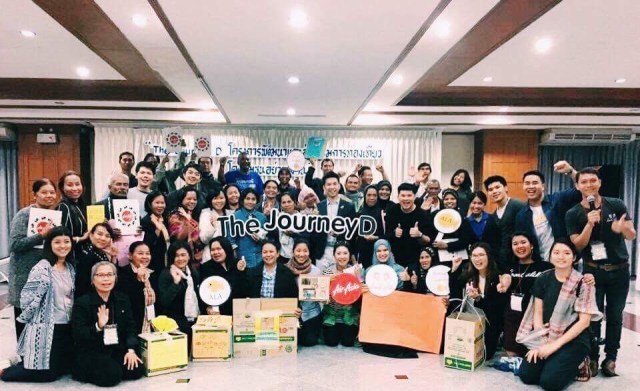
As an innovator, Fah had a rather strange view in which she did not look for mind-boggling or extremely brand new ideas. Rather, what Fah wanted to see was the execution of one’s ideas. “The core content of Design Thinking is still the same, focusing on people who we aim to target but we applied in Thai context which is in accordance with the principles of this place.” – she said.
In playing fair and square, many opportunities have opened for Fah and her team. They have run numerous workshops in many provinces in Thailand, and have recently incorporated their programs in the optional curriculum for teachers under the Ministry of Education. Fah has much of her focus set on those who can make a large impact on the current situation such as Educators and Students. The advantage of using design thinking in both a business and social context, according to her, are the perspectives that she could gain from working in both sectors. And enhancing those benefits was what Fah and her team aimed for.

To serve her fervent desire to reform education, Fah co-initiated “REDESIGN EDU” where she taught Design Thinking to local teachers so that they would be able to utilize the process for innovative teaching approaches that are tailored to their students’ development. There were ups and downs in her adventures with REDESIGN EDU, but among those memories, the time when she visited a rural school in Chiang Mai – Northern Thailand – to change the school’s outdated teaching approach left the most memorable impression on her as well as on us through her story.

The school was situated on a mountain and it took two hours or more to arrive. To the director’s worry that Fah’s team would not come, she informed them that the trip took no time. It was far from an average school as the place was so cramped that Fah had to hold the workshop in a nearby temple and even set up a screen in front of a Buddha statue. As teachers and students gathered, she quickly picked up what the problem was about. Since the school was in the mountains – even further from innovative education – teachers were simply using Problem-Based Learning in their curriculum.
Another big problem was that the parents also failed to see the advantages of using this concept, and instead tried to focus on results – the testing scores – which in turn, affected students’ learning. Upon reaching to the director, Fah learned about her former educational background as a teacher and her dream to transform education in the school. Both of them talked for long hours about her passion and her hopes, inspiring the whole team. She was still working hard to make an impact on education and create new methods through which teachers can instruct more effectively and students can study less rigidly. “It’s not about one person in a small school. But this is about the passion and vision of the future change-makers in Education in Thailand.”
When being asked about the future of the project, Fah said, “For me, I am planning to study Master Degree on Marketing in Thailand. And I hope to apply my specialize to create value and leverage ALA and LUKKID. In the next 5-10 years, we also expect to see the new changemakers who have human-centric mindsets try to change the Thai Education system. If such a future is true, the schools and universities will not be only places for learning, but also for producing high-potential students who will be next generation’s leaders in Thailand.”

From Law School to Laying Foundations: How one Man is Changing Korea’s Indie Scene?
The story was originally posted on:
http://changemakerxchange.com/hyojun-shin-crowdticket/
Story written by Duy Nguyen – Photos shared by Hyojun Shin
The music game has never been easy on its new players, especially in a market so dominated by one genre like South Korea. Indeed, many budding independent artists have succumbed to the power of the massive K-pop wave, but there is a man determined to turn the tide. Hyojun Shin, a 29-year-old Law graduate, turned into a music entrepreneur and founded Crowdticket.krin Seoul, dedicating the last two years of his life to empower self-made musicians through various funding programs and social media campaigns. He is here now to share his experience with us.
“I was really crazy about rock music back then” – Hyojun smiles as he reminisces his years in high school. Young and free-minded back in 2004, he was part of his school’s rock band while fostering the dream of becoming a musician one day. Before he could pursue his goal, however, reality hit hard. His parents refused to send him to the art school for its high cost and low career prospect. “And just like that I gave up on my dream,” he confessed.

Living up to his parents’ expectations, Hyojun attended Dankook University, majoring in Law. The degree helped him secure a well-paid job in the Law department of a construction company. However, the perks of an affluent life could not quite fill in the gap left behind by his teenage dreams. In his own bold words, Hyojun admitted that not pursuing his dream to the very end made him “feel like a loser”.
For a few years, while staying in touch with his artist friends, Hyojun had become aware of the difficulties faced by artists. “I knew a lot of good musicians who had to work in restaurants during the day to afford to perform at night for little or no money,” he said. It was extremely hard for promising independent artists – under the influence of the K-wave – to get by thanks to their own talent. Compelled to improve the outlook for such musicians, he set up a small project that would later become Crowdticket as it is known today.
What exactly is Crowdticket and how does it work? In a nutshell, Crowdticket is a medium to connect artists with a potential audience, along with helping them with fundraising and promoting their names on social channels. This includes features such as running a fundraising campaign, providing venues for concerts, designing tickets and souvenirs; and offering advertising on social media networks like Facebook and Instagram.

Building the foundation for such an ambitious idea proved difficult. After quitting his job, Hyojun sought financial backing and then spent the following six months building the web platform with his friend who works as a software developer. By February last year, the beta version of the service launched and to his delight, it was a great success. Funding for the project began to flow in, and with that much progress made, the prospect of this business became ever so clearer to Hyojun and his team.
Finally, in June 2016, Crowdticket.kr went live. Since then, it has been supporting 70 projects for independent artists specializing in classic, hip-hop and indie music, alongside small plays and musicals, at an astonishing rate of 6-7 projects per month. These shows are normally coordinated by Hyojun’s team, but it is the contributing musicians that decide the content.

The website has been fairly victorious in its activities, mainly thanks to all effective advertising and the consistency of the shows. There have been bumps along the ride as well, such as an unfruitful crowdfunding effort in the city of Busan, where few people were willing to invest. As it turns out, supporting up independent artists was not everybody’s cup of tea, especially through a newborn crowdfunding platform like Crowdticket, and this is what Hyojun considers to be one of the largest obstacles to the growth of his business – to accommodate different views on their project and to make themselves and their goals clear to the targeted market.
Having been in operation for over a year, Crowdticket has had a number of parallels drawn between itself and other crowdfunding pages like the international Kickstarter or Korea’s well-known funding platform – Tumblbug. Crowdticket’s founder, however, is confident that his platform is unique. He considers Crowdticket to be a more artist-oriented platform, catering exclusively for the needs of Koreans and most importantly, it not only provides funding, but also aids the artist in establishing themselves on various genres of social media to appeal to a bigger audience, thereby gaining more ticket sales to back their event.
What’s more, Hyojun claims his ticket-funding model helps build a connection between the audience and the performers before the latter appear on stage. On the one hand, the ticket buyer feels good knowing they played a part in making it happen, that they are directly supporting the artists they come to see. On the other hand, the artists will play to their best because they are performing for the people who made their performance possible. This mutually supportive relationship, in Hyojun’s opinion, can create a whole new experience for both parties involved.
Nowadays, Crowdticket is reaching out to a higher level after striking gold upon inauguration. Recently, it won the Korean government’s competition for startup projects, receiving a grant award of $45000. With this reward, Hyojun plans to take the service to another level by hiring new staff and employing new marketing strategies on and offline. He is also planning to diversify its activity into the realm of fine arts exhibitions in the future.
Looking back, Hyojun Shin is still humbled by what he was able to accomplish in such a short amount of time. “It was scary. When I quit my job, I was 26, and all my closest friends were already making a lot of money and even preparing for their marriages. I had to start over from the very bottom,” he added, “As I achieved bigger things, I became more and more confident. It turned out how other people lived didn’t really matter. You just need to focus on your dream.” Indeed, it is truly amazing how far dreams can take people and how a simple idea, when fueled with the right amount of determination and expertise, can grow into something so vast and meaningful.

inclusion, with a lowercase i: Creating a Better World for the Disabled
The story was originally posted on:
http://changemakerxchange.com/theseabilities-ken-chua/
Story written by Nhi Luong – Photos shared by Ken Chua Tsai
15% of the world’s population are disabled, meaning roughly 1.125 billion people are living in exclusion from a society that talks a lot but does little to facilitate the needs of disadvantaged people. It is ironic how the media would never miss a chance to boast love and understanding and togetherness, but just a few people would take some time out of their precious days to research and understand that we are too busy chasing fortunes to bolster our bubbles to realize that there is a community living among us, yet so separated from us. The fact is most disabled people still live in isolation and poverty due to the discrimination, often caused by pure ignorance masked as sympathy, in the community and workplace. This deepens the lack of contact and information other citizens have on People with Disabilities (PwDs). As humans, we detest being left in the dark, so we start making assumptions and building stereotypes to make sense of things. The grave consequence is not to be shunned anymore, because stereotypes, with time, turn into stigmas.
With Sympathy being the main emotion drawn from the public, false realities of positive social impact continue to be pervasive whilst PwDs’ living conditions keep deteriorating; that is, until Ken Chua took it upon himself to create a truly inclusive movement to “Disable Disabilities” with his social impact startup, (these)abilities.
(these)abilities draws upon inclusive design and technology to invent products, both hardware and software, enabling PwDs to easily maneuver. (these)abilities’ ultimate mission is to promote equity, keep people well-informed on the sensitive subject to form accurate perspectives on disabilities, and removes the stigma that has long hindered PwDs from reaching their fullest potential, thus construct an inclusive community where people with and without disabilities live and work together just as we should. Ken believes, to disable disabilities is to unearth and unleash the potential within PwDs but never thought existed. This mission can only be accomplished once we stop making things easier for those have it easy and start making things possible for those have it tough.

The Base
Nine years ago, Ken Chua volunteered as a Teaching Assistant at the Cerebral Palsy Alliance of Singapore (CPAS) and harbored his dream for a disability-friendly environment in Singapore and across the globe after having witnessed how overlooked and underserved Persons with Disabilities were, and how society could accept that as the status quo. He then graduated from a University in partnership with MIT which is Singapore University of Technology and Design where he researched and developed products for the Deaf. The years that followed, Ken continued to better himself as a designer and an engineer all the while picking up tips on business management through jobs at celebrated companies including the world’s 3rd largest aircraft conglomerate, Embraer, where he introduced inclusively designed aircraft features for PwDs within a futuristic aircraft cabin interior concept. Eventually in 2015, the explosive passion he had developed years and years before could no longer contain itself; his body ached for a revolution; Ken created (these)abilities.

The Change
(these)abilities’ small core team of 3 now manages a talent pool of 30 people across the fields of design, engineering, clinical medicine & disability, all committed to directing our world towards true inclusivity by working together to make differences through their inventions, which come in different forms and serving different aspects in daily living. They have reimagined public bus layouts and added a safety docking device to ensure that each bus can now carry three wheelchair users instead of one. The invention was put into use during the 2015 ASEAN Para Games to ferry more wheelchair-using athletes per ride. The keyguard they manufactured to help people with upper-limb mobility limitations is less than half the price of the existing models, and is fully customizable. In the 21st century, where access to the internet is seen as a universal human right, limiting a PwD’s access to a keyboard is equivalent to limiting their access to a computer and subsequently, the internet. A keyguard solves that problem, but has been too expensive and inaccessible until (these)abilities introduced their model that uses computer vision to scan any keyboard or tablet button layout and translates that into a 100% compatible keyguard. They also collaborate with large multi-national companies to turn their existing products & services to possess inclusive features that make it more functional for PwDs. Recently, they, alongside with Grab, developed a new interface for the app to simplify the ride-hailing process for users who are Deaf or visually impaired. To Ken, (these)abilities is not about doing favors for the disabled community, because in his eyes, they are not disabled. With burning conviction, Ken states that these people are only born differently abled. Expunging disability from the dictionary – this is what (these)abilities is about and is doing. In recognition of their radical cause and constant efforts, they were awarded the Best Tech Social Enterprise of the Year 2016 in the ASEAN region.

What is refreshing and remarkable about their philosophy is that they do not just ameliorate the conditions for PwDs, they do so together with PwDs. Ken told us, a friend of his had a spinal cord injury, which means he is paralyzed from the neck down. This friend is also a talented mouth painter, but because of the inconvenience of having to require the assistance of others with the setting up every time he wanted to paint, he asked for Ken’s help.
“Can you invent something for me?” – the friend asked.
“No,” Ken answered, “I can’t do it for you, but I can do it with you,” “I will teach you how to do it, and you will do it yourself, with guidance from me.”

(these)abilities acts as the guidance. The creator remains PwDs. Whoever wants to take the lead, leads. That way, the satisfaction of ownership belongs to PwDs, and that might be just what they need: the knowledge that they are able to completely change the face of their community by themselves.
The Message
(these)abilities is not just a mere company bringing out innovations and casually improving 1 billion people’s lives every now and then, it is also raising awareness of 6 billion others.

So very often, people without disabilities get uncomfortable in front of people with disabilities. Not that we are narrow-minded, we just do not know how to act lest we do something that comes across as offensive. But also so very often, not all PwDs are that sensitive. As a way to make this fact known, Ken organizes gatherings for people with and without disabilities to socialize and connect. This is a safe space for both ends and an occasion where people without disabilities can shoot any questions they have in mind. Here, questions however silly are always met with warm welcome. Yes, even, “How do wheelchair users have sex?” or “Can blind people be racist?”
The message should be spread that the conditions PwDs are living in are not their identities. They are so much more. They are the colors they love, the food they crave at three in the morning, the words they speak, and the actions they take. So next time you meet a person with a disability, be yourself. As Ken has proved to you, that person, after all, is just another fellow human being.
The Future
(these)abilities is currently in collaboration with the Singapore Disability Sports Council for a project, named #GiveHourTime. The project’s aim is to call for more volunteers to unlock the potentials of PwDs through parasports. Playing sports, PwDs not only learn, improve, and showcase their skills as athletes, but also boost their confidence and health as a person. If you want to be a part of this great cause and platform, reach out. They guarantee it will be fun!
If parasports is not your thing, you can still help create an inclusive society with (these)abilities. Ken says you are always encouraged to partake. Get in touch with him and the team at hello@theseabilities.com.
You are the key to the future.

“It doesn’t take rocket science to disable disabilities. It only requires a level of empathy and creativity” – Ken Chua Tsai.
A Bright Future with the Eradication of Human Trafficking
The story was originally posted on:
http://changemakerxchange.com/kieu-trinh-nguy-th-moving-to-raise/
Story written by Anh T. M. Chu – Photos shared by Trinh Kieu Thi Nguy
In 1948, the first international human rights’ instrument – “The Universal Declaration of Human rights” was adopted. It states that “All human beings are born equal in dignity and rights and it prohibits slavery in all its forms”. However, until the 21st century, trafficking in human beings still exists as one of the most grievous problems in the world, especially in developing countries like Vietnam.
According to the statistics the Steering Committee for Crime Prevention and Combat, in Vietnam, during 2011- 2016, there were nearly 2380 cases of human trafficking with more than 4928 victims. Therein, more than 85% of them are women and children. In addition, the targets of trafficking in human beings are normally women between 18-35 years old or teenagers living in the countryside, mountainous area or near the border. Their impecunious conditions trigger many serious issues such as unemployment, low educational level, lack of knowledge and career orientation. Moreover, child trafficking victims are usually homeless children with a dearth of care, education, and family’s management or children being abandoned, kidnapped and lured into the trafficker’s trap. All in all, it is clear to see that incomprehensive awareness is the main weakness that traffickers use to take advantage of local people. Although human trafficking has been an excessively urgent problem in Vietnam for many years, Vietnamese government still lacks official programs to educate people. Combining with the drawback of a low educational level, there is no likelihood that people in these areas can fully comprehend the dreadful threat, which is really close to them. As a result, the establishment of an innovative and practical project to deal with this problem becomes urgent than ever before.
Acknowledging the urgency of educating people about human trafficking and how to avoid it, a project named “Moving to raise” has been launched by Sustainable Development Club (SDC) to fulfill those needs. Ms. Trinh Kieu Thi Nguy is the leader of this project. Currently, she is a student of The Diplomatic Academy of Vietnam, majoring in English for International Relations. Trinh’s story commences with a project called “Humanitour” – a charity tour organized by SDC in 2011 to mountainous areas. Albeit the fact that human trafficking has no longer been a strange problem to anyone in these places, everyone was very surprised when they realized that people in these regions were very indifferent about severe consequences they might have to tackle. While the number of human trafficking victims keeps augmenting every year and traffickers’ trick becomes more and more sophisticated, people, especially those who live near the border are still not aware of the terrifying threat that is really close to them. Therefore, to deal with this problem, SDC decided to implement a project to enhance social awareness about human trafficking. The project has officially been launched since 2015 after receiving sponsorship from YSEALI. M2R carries out a mission to build a fully- equipped community that is strong enough to fight against trafficking in human beings.

The target of the M2R project is secondary students. Principally, the project concentrates on ninth-grade students as at that moment, they will face up with two essential choices: moving on to high school or putting the end to an academic path to go to work. The first selection seems to be optimal, however, you should notice that these children live in the mountainous area. Therefore, their high school will be far away from their home. Moreover, due to their family’s condition, they cannot even afford their daily needs not to mention tuition fee. Nonetheless, if they choose to abandon schools for labor export, at the age of 15, they will easily fall into the trap of traffickers.

Talking about the implementing format of “Moving to raise” in each school, they would organize two camps. The first camp, which was held three months before the second one focuses on delivering comprehensive knowledge about human trafficking for students. While during the second camp, students had the chance to participate in practical anti-human trafficking activities in order to be prepared with many useful skills such as safe immigration, self- defense, community reintegration, etc. Unlike other programs that only deliver messages through theoretical words, all M2R activities were highly interactive. To encourage the attendance of their main targets, which are secondary students in mountainous areas, Trinh and her team have come up with many lively and creative activities such as interactive plays, movie sessions, group discussions, group works, drawing competition, and knowledge ringing the golden bell game. Being involved in many stimulating cases, students in these schools would understand more thoroughly about its severely dangerous threat. Moreover, through multiple realistic lessons, they also gained the opportunity to learn several ways to avoid and combat in case they face this issue.
However, the process to turn this project into reality was not easy as pie, M2R members had to face up to a number of difficulties. At first, one of the camps was piloted in 2014 and they had not received official fund yet, so the project’s scope was very limited. Even after they excellently received the sponsorship from “Seeds for the future” of YSEALI, M2R still retained many drawbacks such as working with the local community as human trafficking is a significantly sensitive topic. Combing with the fact that this project was sponsored by an international fund, M2R was examined very carefully by the administration. For Trinh, this was the first time she had ever been a leader in a project and this made her a bit worried as she knew she would have a thousand things and responsibilities to bear in mind. She was afraid that she would not be able to accomplish the tasks as everyone expected. Nevertheless, leaving those worries behind, Trinh valuated this as an opportunity for her to explore her own capability and gain leadership skills. Despite all the difficulties they have been through, what Trinh wanted to express most is that she was very lucky to have such enthusiastic members as well as volunteers in this project to turn the lessons for children in these areas become more lively and interesting. She still remembered her first camp, which coincidentally happened to be her birthday, after a guy in her team shouted out “Today is Trinh’s birthday”, 500 secondary students in Yen Bai together with M2R members sang a “Happy birthday” song for her. That must be one of the most memorable moments in her trips.
From October 2015 till June 2016, M2R had brought their amazing ideas to three schools Lao Chai – Yen Bai, A Lu, and Ngai Thau – Lao Cai, which were hotspots of human trafficking. During that period, they organized six camps for more than 1000 secondary students as well as local people to address this dangerous problem. Concurrently, they also supported fundamental things such as food, clothes, and other school supplies for students. Furthermore, after their camps, M2R collected a significant amount of information to build a sufficient database in order to bring all knowledge to everyone in our society.
Not only organizing camps in schools but “Moving to Raise” also held up a massive event in Hanoi comprising of a play called “H’lub – When we love them” and a sequence of sub-events such as exhibition, musical night and much more In Hmong language, “H’lub” in Hmong language means love. Therefore, through this play, the organizing team hoped to deliver their message, which was full of sympathy, humanity, and love to human trafficking victims, who have been trampled and tortured both physically and mentally by those cruel crimes. Accompanied by nearly 400 people attending, many victims or we should call them by a better name – our survivors, street children also involved in this event. The play was written based on a true story that Trinh’s team had got the chance to listen to. During a camp, they met a little girl, who was a “survivor” after being sold and captured in China since she was five years old. Notwithstanding the fact that she has come back home to her family, nothing could compensate for the pain and loss she had suffered in that “nightmare” period. Her affliction was so substantial that it affected her characteristics and mentality, which made her become very shy when talking to other people. Consequently, for human trafficking victims, being rescued was not enough but they also craved for sympathy, share, and love from the community.

Human trafficking is one of the most considerable problems that requires the concern of every individual in this society as it brings forever torment to the victims. As Trinh shared with us, in the future, she hoped that “Moving to raise” could be expanded not only in scopes to more areas in Vietnam but also to more people in the world. If there are more and more projects like Moving to Raise implemented, a bright life with the eradication of human trafficking is no longer delusive.

Human Library Singapore And The Hope To Break Down Social Barriers
The story was originally posted on:
http://changemakerxchange.com/kelly-ann-human-library-singapore
Story written by Trinh Ha – Photos shared by Kelly Ann Zainal
Ever thought of what would happen if you sat down, and had a sincere and objective conversation with a person who shares utterly contrasting standpoints? Chances that it could bring you closer together?
Yes. Kelly Ann Zainal believes so.
A Dedicated Young Woman
With the enthusiasm for mental health and human connections, Kelly Ann Zainal graduated with a major in psychology from the National University of Singapore and currently works as a mental health researcher specializing in eating disorders in the day and a volunteer for social campaigns by night. In addition, this talented woman is also the lead organizer of Human Library Singapore, which is a special library that allows readers to read and get to know human beings like the way they would with a book.
Don’t Judge a Book by its Cover!
After graduation, Kelly has been a regular volunteer with prisons and taken up the role of a befriender of inmates or ex-offenders, helping them integrate back into life when they finish their sentence.
“When I talked about my job to the people I’m working with, they were always very surprised and shocked. Since I’m a girl and went to prison, they worried that something bad would happen to me. And then every time I found myself having to explain that those assumptions were, in fact, contradicted the truth. Many of them were very helpful and motivated, they wanted to make a change in their lives for their families, their parents, and their mates, these kinds of things,” said Kelly.
Through volunteering and participating in various social events, Kelly realized that there are so many unknown misunderstood narratives in Singapore. And as time goes by, she discovered her passion for bringing people together, eradicating misconceptions and prejudices and felt a very strong sense of wanting to do something for the community.
However, it was not until last year when she attended a one-off Human Library session at the Singapore Management University that she grasped the most effective way of eliminating those obstacles was to develop mutual respect and comprehension among one another. The openness of living books made such a deep impression on Kelly as well as her Co-Founder that they felt the urge to find a way to replicate this model on a larger scale and make it more accessible for more Singaporeans to know about Human Library.
The Art of Storytelling
In a traditional library, books are read and discussed or shared among like-minded readers. Likewise, visitors to Human Library can ‘borrow’ living Books with ‘titles’ and engage in small-group conversations. These so-called Readers are expected to log into the online booking system and register prior to the event, but walk-ins are accepted too.
Originated from Denmark in 2000 as a “movement for social change”, Human Library has the potential to help people hear stories of those who are different from them and be the spark for the development of a more compassionate community.

These Books are not fictions. They are real experiences, real pains, real feelings, representing groups of people from diverse backgrounds who are misunderstood or discriminated against in society. Through Human Library, they can tell their innermost feelings, be heard, understood and empathized with. The Readers are encouraged to ask questions out of curiosity and respect, helping them gain a deeper understanding into each Book’s life.

“It is also important to understand that everyone has a story. People are not folders that can be conveniently labeled and slotted into filing cabinets. It’s about time we stop judging and start thinking. We lose so much of our ability to tap into the strengths of one another if we simply write people off because of the labels we have conveniently ascribed to them.” – Sherlin Giri, a widow who juggles raising her two children, her career and her passion for writing, shared her inspiring story at Human Library Singapore #3.
Human Library is such a powerful tool to get people to just sit down, listen to the people you normally would not get the chance to talk to or ask questions for fear of offending them, put yourselves in their shoes and really empathize with them for the reason that you cannot fault someone’s personal experiences.
Human Library Singapore and the Public Response
The beginning phase of the project went fairly smoothly. They received a $3,000 grant from the Singapore National Youth Council, who gives sponsorships to youth groups with organizers below 35 years old.
Nevertheless, for the first event, Kelly and her three socially conscious co-founders didn’t know what the demands and reactions to Human Library would be in Singapore. Therefore, they intended to host it for 150 participants and 20 human books, but 2 weeks after the release of the Facebook event page, approximately 1,000 people showed their fascination and signed up for the event. The team were incredibly surprised and happy that Singaporeans are really enthusiastic about this initiative, so they decided to scale up the event and double the number of books. In the end, the event captivated more than 400 readers who heard stories from 49 human books.

The outcome was amazingly encouraging and illustrated a strong confirmation that Human Library does belong in Singapore, that they should continue their efforts. Kelly also proudly credits the support of her avenger team featuring 10 organizers in total as part of the core team and over 30 volunteers to have successfully carried out such a massive scale event.
Since then, they have conducted 2 more big editions and a few smaller ones in between.
The first 2 events held on October 30, 2016, and March 5 this year took place in the city center so it attracted mostly youths. Then it struck Kelly that whether they could reach out to a wider range of audience. Therefore, the third run occurred in a community setting, the heartlands of Taman Jurong so that aunties and uncles, grandpas and grandmas could come for the event as well. The turnout was really good with 234 readers and 42 books.
Approaching Human Books
At the outset of the project, only a small number of Singaporeans knew about Human Library and its concept. Hence, it started with the team contacting people and persuading them to be ‘books’. This group would be their friends or friends of friends, people who they encountered during volunteering days.
The work was relatively painstaking and time-consuming but they managed to put together a miscellaneous ‘library’.
However, the first event attracted the press a lot so Human Library Singapore appeared in various newspapers, online news and even the BBC video entitled “The Human Library where you can borrow someone’s story” that went viral. Thanks to that, more and more people indicated their interest to be ‘books’.
The team decided to put up an online application form on their website so that people can just drop their stories and then before an event, once the detail of the coming event has been finalized, they will send an email to applicants and ask if they are willing to join. If it is one’s first time being a book, the team would individually interview them to make sure they are clear about what Human Library is, what they are supposed to do as Books and whether they need any assistance.

Human Library is a 100% non-profit organization and everything is free. Human Books also appear at the library to share their stories with the public on a voluntary basis, with no salary or income. Therefore, Kelly really appreciates their spending time there and their courage to speak up as well.
Aspire to Inspire
Needless to say, Human Library Singapore creates a platform for the public to meet people from all walks of life that they probably would never come across, with the goal of erasing labels in society.
The team also tries to connect with a call to action that after the library session, readers will do or volunteer for something in order to actually channel this strong empathy and responsibility they are feeling into something actionable.
Personally speaking, with the influence of Human Library Singapore, Kelly wants to empower other people to organize their own Human Library events, and they can be a crucial source of advice and information or connection to Human Books.
For more updates about the coming events or registration to be a Human Book, visit the Human Library Singapore Facebook page or website: https://www.facebook.com/humanlibrarysg/ | https://www.humanlibrarysg.org/

Little Marios – Empowering Communities, One Mushroom At A Time
The story was originally posted on:
http://changemakerxchange.com/hao-yu-quan-little-marios
Story written by Dang Nguyen
“The ultimate goal of farming is not the growing of crops, but the cultivation and perfection of human beings.” – Masanobu Fukuoka
In the world of aspiring entrepreneurs and changemakers, Quan Hao Yu is far from a strange name. Founder of many projects including his local college’s AIESEC, Homoto, and Little Marios, he is a force of change – an embodiment of the youthful spirit and a symbol of action. He has been actively working in social enterprises to improve the quality of life in his hometown and bring about big changes through his little mushrooms. In a short span of a morning bus ride, when we had a chance to talk with him, we were captivated by what he had to share.

Unlike many social entrepreneurs who rose from hardships and endeavored to improve lives, Hao Yu grew up in a relatively well-off family. But at a young age, he was already aware of his stance in society and felt compassion towards other less fortunate human beings. Many children out there have access to neither good education nor a safe home. And Hao Yu was determined to change that.
At the age of seventeen, he left his home in Kuala Lumpur and travelled to Penang to pursue his studies in electrical engineering. But Hao Yu wanted more in college than just a single degree, so early on he made a dive into social entrepreneurship and created many projects, none of which lasted for long, however. Around the same time, he stumbled upon a chance to turn his lifelong passion for social justice into reality as David Chew – a senior at college – introduced him to an intriguingly strange idea of growing mushrooms from coffee waste. Hao Yu unhesitatingly accepted the offer and both of them started working on the project together. Before long, from a fervent interest in entrepreneurship and a desire to aid underserved communities, Little Marios came to life.
In 2013, David and Hao Yu first pitched their idea at the Youth Social Entrepreneurs Program where they received an advice to incorporate a sense of charity that forever changed the face of Little Marios. “It was a project initially, like the one that Starbucks did. We were just trying to grow mushrooms out of coffee waste, not generating money, you know. But after we took it to an innovation competition, the judge panel advised us to incorporate a social part into this whole project. And that’s what we did – that’s how everything started,” Hao Yu said.
What’s up with Little Marios?
As earlier mentioned, Hao Yu’s dream has always been to improve the quality of life in Malaysia, for children specifically. Combining that dream with what the project had already been doing at the time – mushroom farming – he brilliantly came up with the name Little Marios. Since Hao Yu and his team were already working with a lot of children at the start of the project, they wanted to have a kid-friendly name. And “Mario” sounded just like what they needed; combining that with the adjective “little” that perfectly describes children, “Little Marios” became the official name. Coincidentally, the game involves a lot of mushrooms too!
As of now, Hao Yu has inherited and is single-handedly leading the project as most original founders already went on to pursue other goals or to study abroad. “It was not my idea, it was my leaders’ idea, I was just a co-founder, not the leader. But after they graduated, some of them left, and currently, I’m leading the team.” Nevertheless, their mission remained the same as Hao Yu and his team strives to introduce the potential of mushroom cultivation serving as the main income source for underserved communities.
Earlier, Hao Yu brought Little Marios to pitch at Singapore International Foundation’s Young Social Entrepreneurs Program. He told us he had learned enough to return to Malaysia and use a social entrepreneurship model to develop rural communities through innovative agricultural activities. In the endeavor to kick-start big changes from tiny little mushrooms, the Little Marios team whole-heartedly hopes to impact many more communities, so as to pass on the agricultural knowledge that can be useful for each individual in the communities to earn a budget to build their own dreams.
We were neither part of Little Marios’ team nor part of his community. But after listening to Hao Yu’s pouring his heart out about the projects and the hopes and dreams he attaches to, we were eager to find out more.
How does Little Marios work?
There are three types of social businesses, according to Hao Yu. The first is about non-human-related problems such as the environment, tourism, and food waste. The second one is human related, but people come to those social businesses to seek help. And then there is Little Marios – the third type – which actively makes an effort to go out and seek for people in need. Throughout the year, Hao Yu and his team would go to various children homes and communities to teach them skills in business and agriculture. A little side note, according to the instructions on Little Marios’ website, growing mushroom is just as easy as watering twice or thrice a day and keeping your eyes peeled for any mold!
Basing itself on mushroom cultivation, Little Marios is an extremely self-sufficient model where people can convert agricultural waste into nutritious food and create money-making opportunities. Such is why Hao Yu does not think his project needs funding. Rather, target beneficiaries – the communities – will be involved in mushroom growing and harvesting process, where they can observe the growth of mushroom and harvest them at their own capacity. “Normally mushroom farms just about the size of a bookshelf can generate up to 100 Ringgit. It’s not too much but it’s good because they can save the money for emergency usage,” he said.
At the same time, the Little Marios team also sells their mushrooms to support the communities. “Sell one donate two” is basically how their aid model works. It is effective because once the mushrooms are delivered, communities can choose to either sell them for more profit or just simply cook them for food. “But our model wasn’t always this effective,” Hao Yu noted. “Sell one each gets a portion of one” was Little Marios’ previous model, which was not as successful as their current one because the team would, instead of donating two-fold to communities, split the profit with their beneficiaries. And as the people in the communities would rather stay away from monetary issues, the model did not stand to gain approval. Now, with a handful of mushroom farms set up in lots of children’s homes, the Little Marios team aims for a simple yet effective operation. Every 2 weeks Hao Yu and his team would go to the communities and replenish the packs so that communities can keep on cultivating and selling mushrooms.
Needless to say, like many other social enterprises, Little Marios’ initial journey was fraught with difficulty. Even though mushroom farming is easy to teach and learn, not everyone felt the need to learn the required skills to make money. Instead, over 50 percent of the communities they had visited simply wanted money, not all the hardships involved in making it. One time, Hao Yu and his teammates went to a bungalow to teach old people how to make a living from agriculture. It was very moving to hear how the people there were virtually starving – one old person even held Hao Yu’s hand and asked if he had food. Surely enough, Little Marios was just what those elders needed – a sustainable source of food and income. Yet when it was revealed that Hao Yu did not come to donate money, and instead wanted to teach skills, the community dwellers were immediately disinterested. As a result, the team walked home barehanded.
Another big obstacle in the young entrepreneur’s path was the space required for mushroom farms. Hao Yu had brought his model to many children places such as homes and refugee schools. But normally those places would be very packed, so they had to experiment with growing mushrooms in almost everywhere else instead of inside the classrooms. For instance, one time, they even tried setting up farms on the rooftop, but unfortunately, it also failed to work as the temperature was too hot for the mushrooms to grow. However, they finally figured a few other places to grow the mushrooms better. Some of which were even looped in their own houses and they called them “our house stores”. They have been living happily with the little mushrooms and treating them as their close home friends.
It was also very difficult for Little Marios to sell their products to restaurants or bakeries because their supply – which was mainly bought from vendors – was not guaranteed with consistency. Coupled with the fact that they had to donate two-fold – sell 100 donate 200 for instance – mushroom stock would fluctuate a lot. As a consequence, they were rejected by many buyers.
But in the end, nothing could stop Little Marios and Hao Yu’s resilience. So every new day was another step closer for Hao Yu to actualize his dream. Ever since 2013, Little Marios has been non-stop proving to be a force that drives society forward, and one that has widespread effects all over Malaysia. Farms can now be found in numerous children’s homes. Whether it is in the rooftop of Dignity for Children Foundation classroom, or a new farm in Charis Home, St Joseph Home, or even a boot camp in Lukut, Negeri Sembilan, each of Little Marios’ farms has become a self-sustaining entity of its own, living up to what the project is all about. And that is exactly what Hao Yu’s genius is – he has created his own ecosystem of mushrooms and enabled big changes to happen from the tiniest of things.
As of now, Hao Yu is not entirely certain of how bigger he wants Little Marios to be in the future or how many more farms to be set up at children’s homes. But what we, he, and his lovely communities do know is that Mario is not going to end anytime soon. And as long as they all keep trying and staying self-sufficient, the end is nowhere near!
A Miracle in The Storm
The story was originally posted on:
http://changemakerxchange.com/ma-mariel-may-obregon-agriblock-builders
Story written by Trang Nguyen
Mariel Obregon uttered her first cry in the city of Tacloban, Leyte, the Philippines. Once mentioned, the Philippines often appears as a “Storm Country” in everyone’s mind. Whenever typhoons make their “short visits”, hundreds of terrible and dreadful devastations are made, including both people and material damages. Conquering in the storm is somewhat a “mission impossible” but surviving after it is way more frightful. Just imagine one day when an uninvited storm knocking and destroying everything around you with all the buildings collapsed, and your neighborhood disappearing for no reason, you, from the-one-who-has-it-all in just a tick, play in the role of the-one-who-lost-it all. What will you do? Cry? Be hopeless, clueless or distressed? Well, this girl does not; she found her chance in all those obstacles and turned them into her own big advantages, both for her and the sake of all Filipinos who are also suffering. And Agriblock Builders was born like a little miracle in the storm. Just to put it simply: What will be the first thing you do when you lose a shelter? The answer is easy: Find another one. However, the real process of actually owning one is maybe not that easy for the accumulation of the building cost, the location and not to mention one big question: If the house can stand after the next typhoon.

Speaking of the typhoon, in 2013, one named Yolanda sweeping through the Philippines, left behind a massive devastation resulting in a high demand but low supply for hollow blocks for housing construction. And this is exactly where the seed of a brilliant idea is sowed. Agriblock Builders was born. According to Mariel, Visayas is an agricultural area with approximately 700 tons of rice produced each year. Consequently, this results in about 400 tons of rice hull, which make up 45% agri-waste there. So what is the concept behind this? Mariel thought she could utilize those wastes to create more affordable, sustainable and greener hollow blocks for construction. And it has been magically and unexpectedly successful.
Two years ago, in 2015, Agriblock Builders was formed in Eastern Visayas, Alangalang Leyte, after a long time of Mariel’s research on a solution for a problem in her hometown in her third and graduation year. Then she founded her own social start-up. The Agriblock Builders was officially established and went into business in 2016 and as she said: “It is like a baby in the startup empire”.
Sharing about the WHY for Agriblocks, Mariel believes that the rights or the access to a strong-quality home should be obliged for anyone and not just privileged for some. In addition, in her hometown, it is both hard and expensive to build a house; as a result, the poor are just able to buy low-quality houses built of unqualified materials such as wood which will unlikely to last after the next typhoon. That is why Agriblock Builders – a manufacturing enterprise was born with its lofty mission of promoting the use of sustainable building materials by utilizing rice hull and converting it into more sustainable, enduring and stronger housing material RHAC (Rice Hull Ash Cement), which are known as the magical agriblocks for the homeless and typhoon-stricken community. The average number of blocks to build an average house will be around 500, and the market price for a block in her local area oscillates from 13 to 15 peso, which means it will cost around 7500 pesos for a house, not to mention other expenses. But for Agriblocks, it only takes about 8 pesos for a block and this means a great bargain for consumers when they can actually build a house with only 4000 pesos, 3500 cheaper compared to using the old materials. Not to mention, agriblocks have been proven to have up to 5 times higher PSI (Pound for Square Inch); they are not only stronger than commercial hollow blocks but they also show their pre-eminence in cheaper price and lighter in weight. So at the same time, Agriblock Builders actually kills two birds with one stone. First of all, it solves the problem of demand and supply. In the first 6 months, it sold 5000 blocks and up to 1200 blocks recently meeting the demand of 20 households. Secondly, Agriblock Builders has been on the process of reducing agri-waste along with the use of cement. Since rice hull is utilized and converted into rice hull ash cement, it can actually decrease the amount of cement used for house building and solves the problem of environmental waste in the area. Above all, all these ideas have truly lived up to Mariel’s Agriblock’s motto: “Helping Nature. Building Homes”.
Nothing is given for free, and nothing is done without efforts and challenges. As a girl majoring in management of the University of the Philippines Visayas Tacloban College (UPVTC), Mariel first struggled with researching on a new field of engineering. She is like a pagan child, trying to exceed in a field that was not meant for her at first. The Philippines seems not to be an ideal place for social enterprise so this puts up a huge barrier for social enterprises just like hers. Also, at the same time, her parents just want her to finish college and get a job in the field of medication and banking. “Think big and differently” is out of the zone. When Mariel first tried to get sponsorship, she was turned down because the investors did not appreciate the idea. However, she did not get depressed; she finally managed by getting help with finance from her teammates and friends. Besides, she sent proposals as many as she could to all the NGOs and the local Government in order to seek for grants. “It’s hard to change people’s mindset,” she added. It is hard for people to accept something bearing the label “new”. The first stage in a product’s lifetime is always full of unexpected things and challenges in making decision of whether to stop or to continue, not to mention all the documents and all the things she had to prepare in the process of business registration, finding the location and of course a small amount of registration fee along with it. But through both observation and judgment of what Agriblock Builders has achieved, it is for sure that Mariel is still doing a great job.
When being asked about the form of the enterprise, she used the word “hybrid”, which means a combination of both NGO and a normal enterprise in her idea. Explaining of this new form, Mariel said that Agriblock Builders is currently subsidizing the price for the consumers, which explains for the price of 8 pesos and at the same time trying to maintain the margin for sales in order to ensure the sustainability of the enterprise. In the future, she hopes that Agriblock Builders can collaborate with construction enterprises so that people can have access to a higher-quality house and higher-quality material for housing and building. And in the next 5 years, she and her Agriblock Builders team will continue improving this brand new product as well as raising the value of it.
Besides working as an active founder of Agriblock Builders, Mariel is also a teaching instructor at UPVTC. However, she still can manage her two jobs very well. She spends 4-5 hours a day at school, and the rest of her time for her venture. Mariel has no longer been a strange face in the field of entrepreneurship since her appearance in the area winner and finalist list of the Youth Entrepreneurship Development Workshop (YEDW) – a developmental workshop for young Filipino entrepreneurs. She is also one of the five promising millennials in the field of entrepreneurship by the NGO Philippines Center Go Negosyo which is in partnership with YEDW.
What Mariel has been doing in all those years of youth is in no doubt. She said that family, friends, and supporters are always there for her. And she is also lucky to find people who share the same vision with her, from her teammates to her workers despite backgrounds and experiences. It seems that this story will come to an end now because Mariel has succeeded on her own track. Her own story will still continue but for our readers, we have learned a great deal from this inspiring person. After this story, you can choose to support her or you may have the courage to write your own. Either way, it is believed that there will always be a silver lining or a real miracle in the storm.
Awesome Shoots
In the summit, we shot 1000+ photos and raw videos. Through some items selected below, we hope they can help you take a deep insight into the change makers’ mind!
Visit The Change Stories’ Youtube Channel here
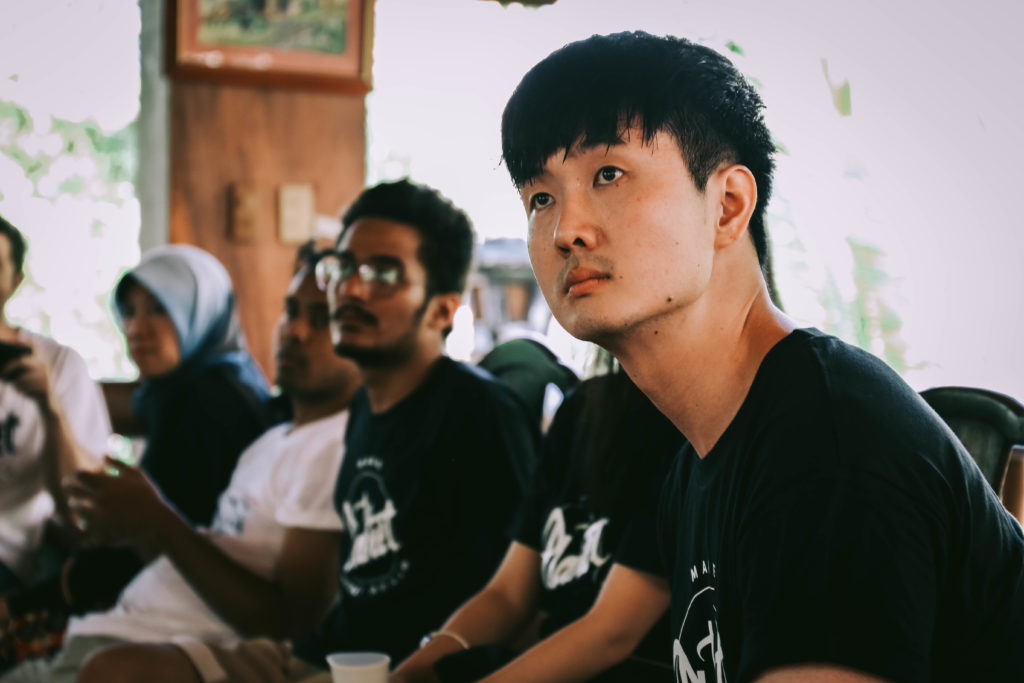
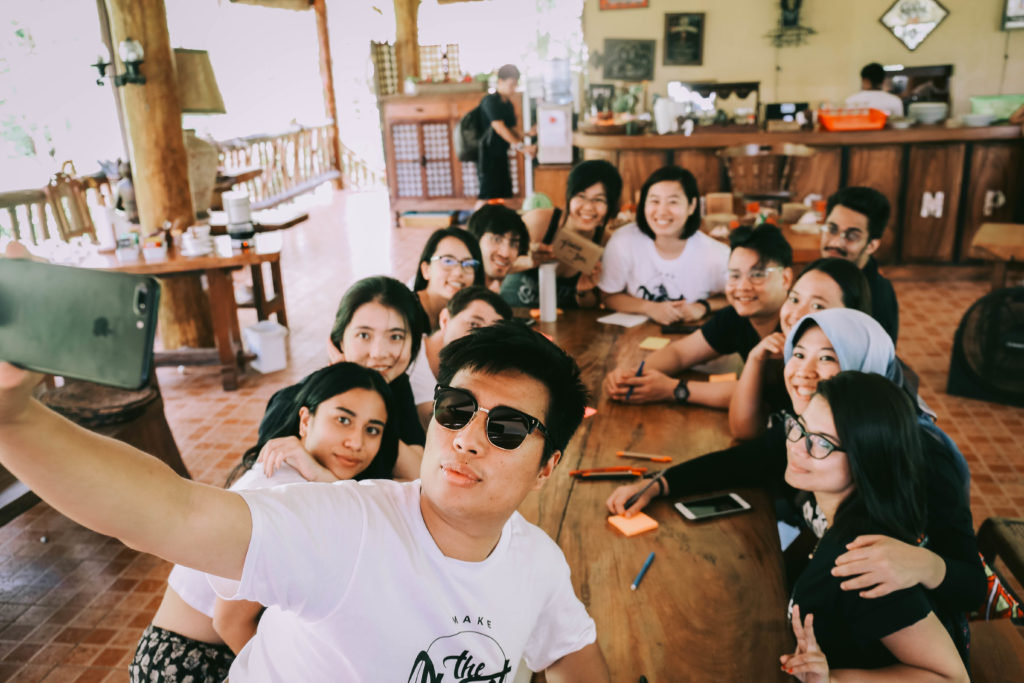
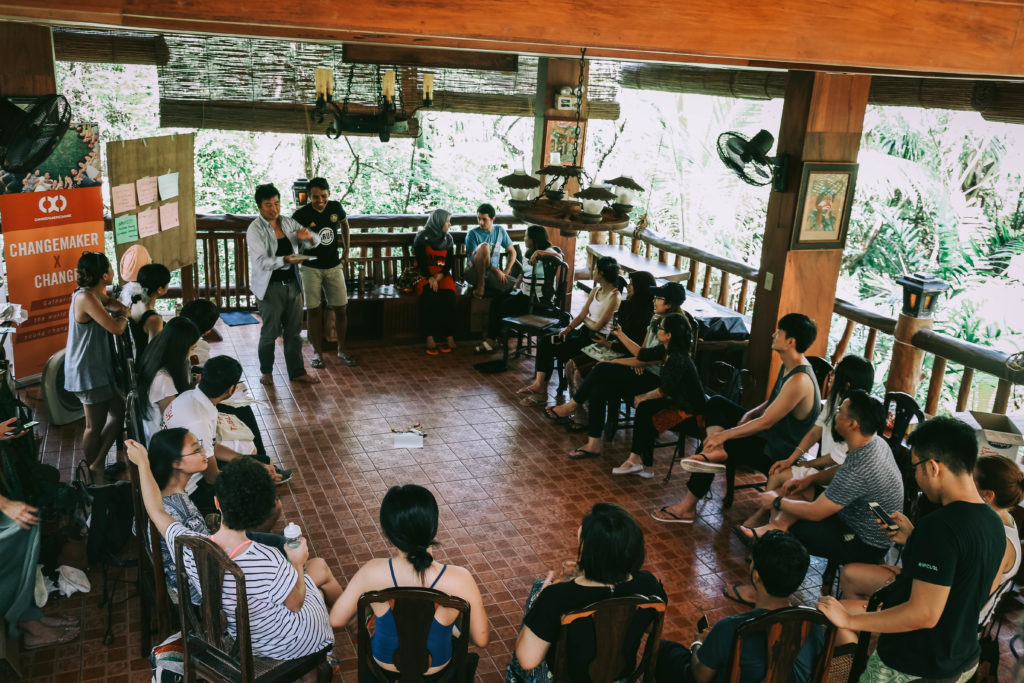
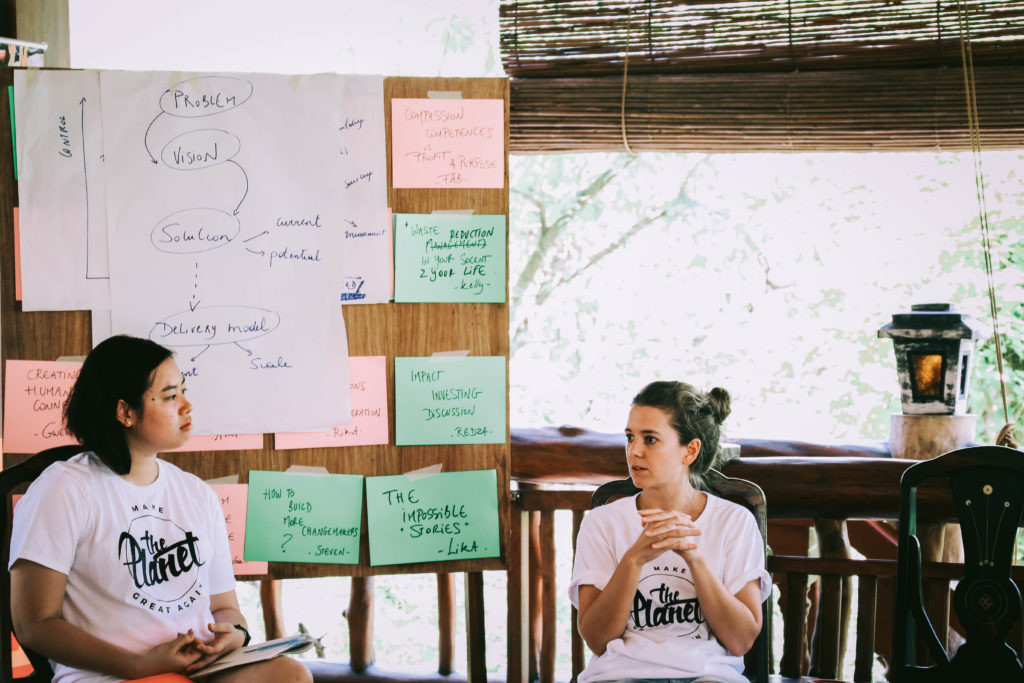
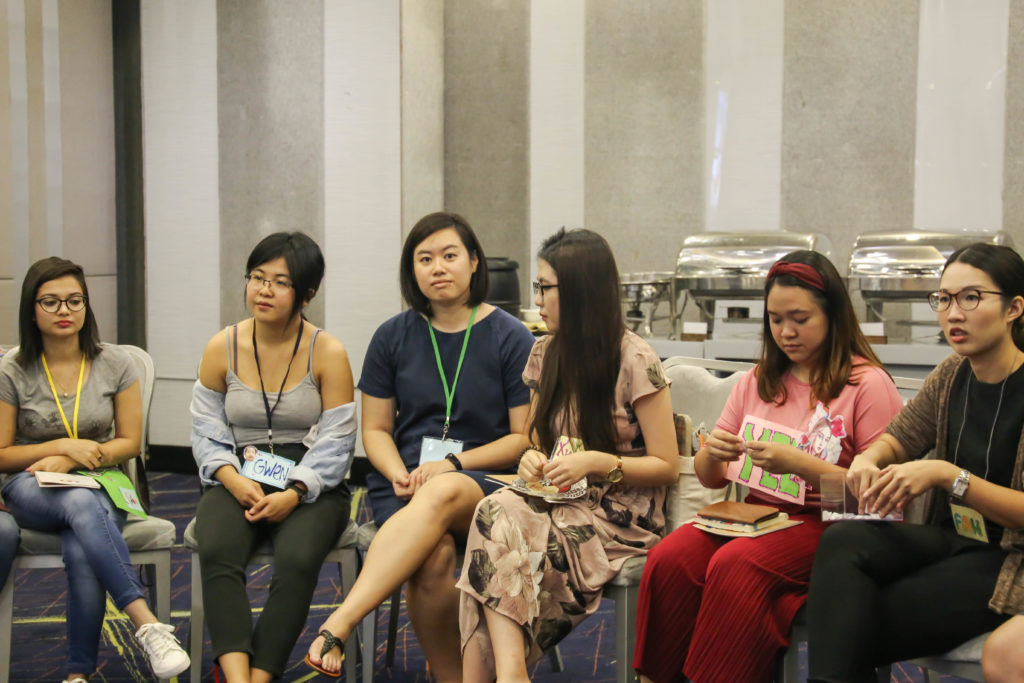
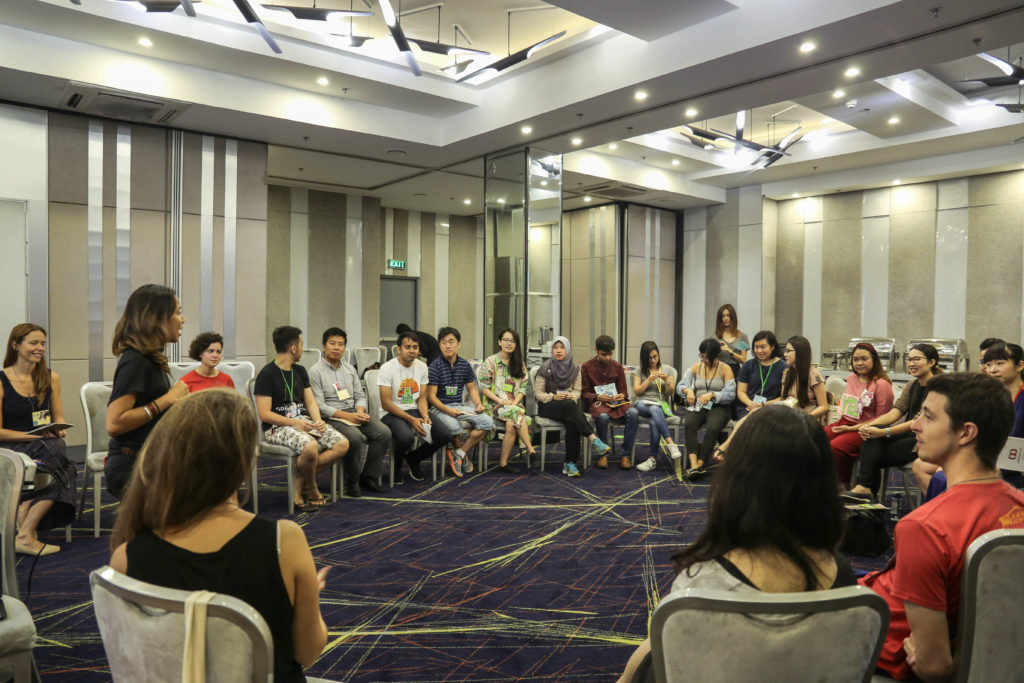
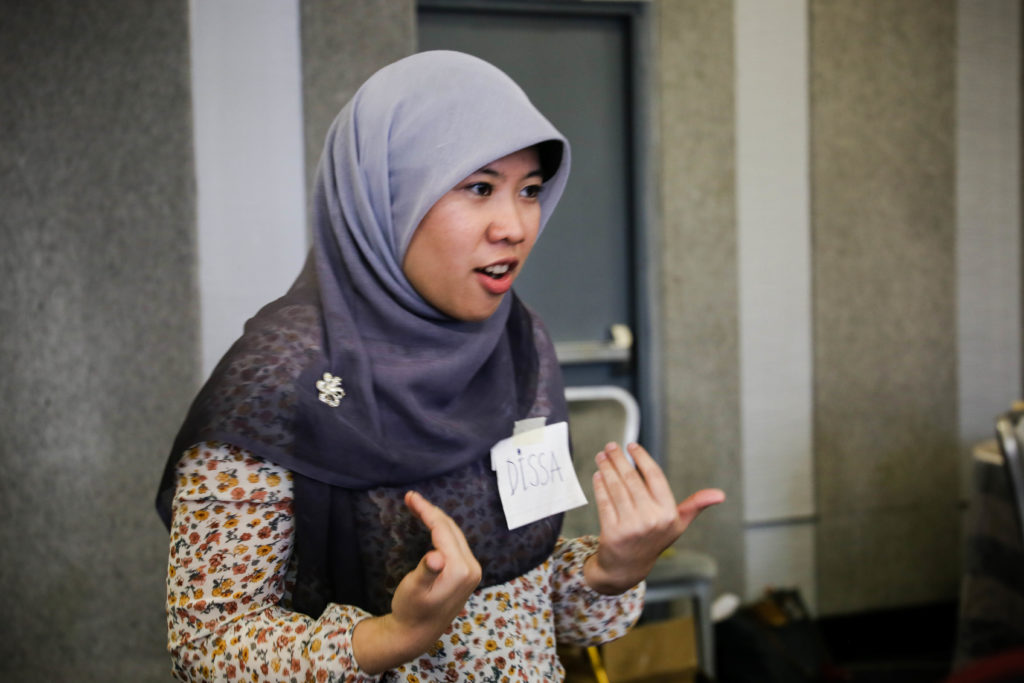
FYI